湖南农大组织胚胎学 习题集(带答案)
- 格式:doc
- 大小:226.00 KB
- 文档页数:40
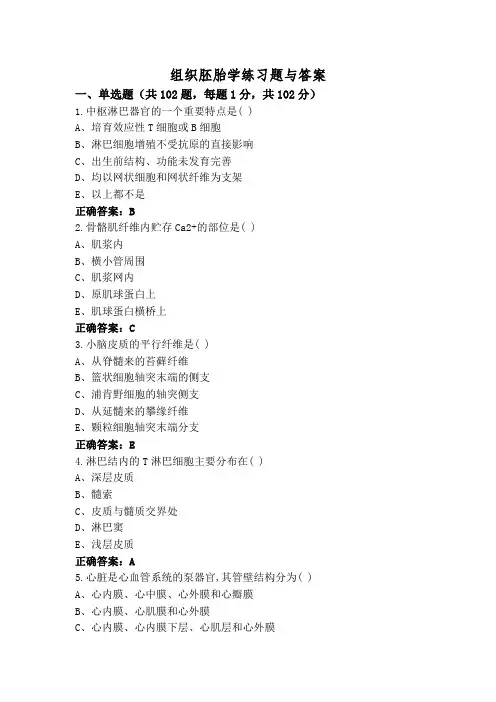
组织胚胎学练习题与答案一、单选题(共102题,每题1分,共102分)1.中枢淋巴器官的一个重要特点是( )A、培育效应性T细胞或B细胞B、淋巴细胞增殖不受抗原的直接影响C、出生前结构、功能未发育完善D、均以网状细胞和网状纤维为支架E、以上都不是正确答案:B2.骨骼肌纤维内贮存Ca2+的部位是( )A、肌浆内B、横小管周围C、肌浆网内D、原肌球蛋白上E、肌球蛋白横桥上正确答案:C3.小脑皮质的平行纤维是( )A、从脊髓来的苔藓纤维B、篮状细胞轴突末端的侧支C、浦肯野细胞的轴突侧支D、从延髓来的攀缘纤维E、颗粒细胞轴突末端分支正确答案:E4.淋巴结内的T淋巴细胞主要分布在( )A、深层皮质B、髓索C、皮质与髓质交界处D、淋巴窦E、浅层皮质正确答案:A5.心脏是心血管系统的泵器官,其管壁结构分为( )A、心内膜、心中膜、心外膜和心瓣膜B、心内膜、心肌膜和心外膜C、心内膜、心内膜下层、心肌层和心外膜D、心内皮、内皮下层、心肌膜和心外膜E、心内皮、内皮下层、内弹性膜、心中膜和心外膜正确答案:B6.在复层扁平上皮之间最多的细胞连接是:( )A、紧密连接B、半桥粒C、缝隙连接D、中间连接E、桥粒正确答案:E7.关于食管的组织结构特点哪项错误( )A、肉食动物粘膜上皮是角化的复层扁平上皮B、腔面有纵行皱襞C、粘膜下层有食管腺D、肌层的肌组织类型因动物种类和吞咽特点而异正确答案:A8.关于I型肺泡细胞的描述错误的是( )A、细胞器相当丰富B、细胞表面较光滑C、I型肺泡细胞较II型肺泡细胞少D、细胞宽大而扁薄正确答案:A9.与呼吸性细支气管结构比较肺泡管的主要特征为( )A、平滑肌薄B、覆以单层立方或单层扁平上皮C、管壁结构少,呈节结状膨大D、存在少量的软骨组织E、管腔较大正确答案:C10.能分泌激素并参与免疫的器官是( )A、骨髓B、淋巴结C、脾D、胸腺E、扁桃体正确答案:D11.关于消化管内分泌细胞的描述哪项错误( )A、分泌胺类或肽类激素B、细胞呈锥体形、卵圆形或不规则形C、分为开放型和封闭型两类D、在HE染色切片上,很容易与普通上皮区别。
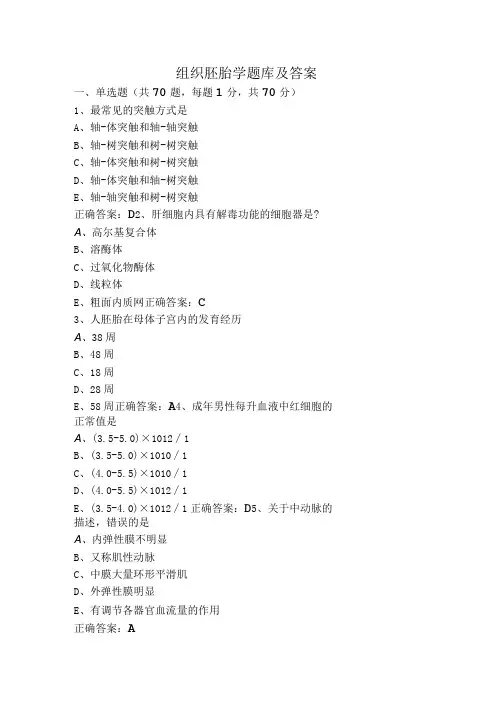
组织胚胎学题库及答案一、单选题(共70题,每题1分,共70分)1、最常见的突触方式是A、轴-体突触和轴-轴突触B、轴-树突触和树-树突触C、轴-体突触和树-树突触D、轴-体突触和轴-树突触E、轴-轴突触和树-树突触正确答案:D2、肝细胞内具有解毒功能的细胞器是?A、高尔基复合体B、溶酶体C、过氧化物酶体D、线粒体E、粗面内质网正确答案:C3、人胚胎在母体子宫内的发育经历A、38周B、48周C、18周D、28周E、58周正确答案:A4、成年男性每升血液中红细胞的正常值是A、(3.5-5.0)×1012∕1B、(3.5-5.0)×1010∕1C、(4.0-5.5)×1010∕1D、(4.0-5.5)×1012∕1E、(3.5-4.0)×1012∕1正确答案:D5、关于中动脉的描述,错误的是A、内弹性膜不明显B、又称肌性动脉C、中膜大量环形平滑肌D、外弹性膜明显E、有调节各器官血流量的作用正确答案:A6、气管上皮中,游离面有许多长而直的微绒毛的细胞是A、小颗粒细胞B、刷细胞C、基细胞D、杯状细胞E、纤毛细胞正确答案:B7、红骨髓的主要成分是A、造血组织和血窦B、造血组织和脂肪C、血窦和造血细胞D、疏松结缔组织和血窦E、骨组织和造血细胞正确答案:A8、下列关于精原细胞的描述,哪项错误A、为最幼稚的生精细胞B、为青春期前生精小管内唯一的细胞C、核型为46,XYD、可进行减数分裂E、直径约12um正确答案:B9、关于肾上腺髓质的描述,错误的是A、髓质内有少量交感神经节细胞B、与皮质网状带交界处参差不齐C、髓质细胞分泌肾上腺素和去甲肾上腺素D、主要由髓质细胞构成E、髓质细胞内含有嗜银颗粒正确答案:E10、关于食管腺,正确的是A、位于内环外纵肌纤维B、分泌淀粉酶C、位于黏膜下层D、为纯浆液性腺E、位于固有层正确答案:C11、关于原始卵泡的特点,哪项错误A、由卵原细胞和卵泡细胞构成B、最多,体积最小,结构最简单C、分布于卵巢皮质浅部D、由初级卵母细胞和卵泡细胞构成E、卵泡细胞多为单层扁平状正确答案:A12、关于内分泌腺的描述,错误的是A、所有的内分泌细胞部存在于内分泌腺中B、腺细胞排列呈索状、团状或围成滤泡C、腺细胞之间有丰富的毛细血管网D、内分泌腺细胞的分泌物称为激素E、激素的作用细胞称靶细胞正确答案:A13、精子的主要运动装置是A、线粒体鞘B、轴丝C、纤维鞘D、外周致密纤维E、顶体正确答案:B14、构成周围淋巴组织细支架的是A、上皮性网状细胞B、网状纤维C、网状组织D、网状细胞E、小梁正确答案:C15、下列哪种蛋白不参与组成细肌丝A、肌动蛋白B、原肌球蛋白C、肌球蛋白D、肌钙蛋白E、以上都不对正确答案:C16、神经元尼氏体分布在A、胞体和轴突内B、整个神经元内C、树突和轴突内D、胞体内E、胞体和树突内正确答案:E17、不属于人体基本组织的是OA、结缔组织B、上皮组织C、肌组织D、淋巴组织E、神经组织正确答案:D18、分化为浆细胞的是A、B细胞B、T细胞C、NK细胞D、大淋巴细胞E、巨噬细胞正确答案:A19、关于垂体神经部,哪项正确A、分泌生长激素和催产素B、合成和分泌催乳激素和加压素C、下丘脑通过垂体门脉系统调节其分泌活动D、合成和分泌催产素和抗利尿激素E、贮存和释放抗利尿激素和催产素正确答案:E20、下列关于垂体门脉系统的描述,错误的是A、连接下丘脑与神经垂体的一条通路B、次级毛细血管位于远侧部C、初级毛细血管位于漏斗部D、由垂体上动脉发出E、是下丘脑调节腺垂体分泌活动的通路正确答案:A21、下列哪项细胞连接又称通信连接A、紧密连接B、半桥粒C、中间连接D、缝隙连接E、桥粒正确答案:D22、关于终末细支气管的结构,哪项错误A、管壁内透明软骨片少B、无腺体C、平滑肌形成完整的环形层D、无杯状细胞E、上皮为单层柱状正确答案:A23、关于脾淋巴小结,错误的是A、位于动脉周围淋巴鞘一侧B、主要由T淋巴细胞构成C、有小结帽、明区和暗区之分D、参与体液免疫E、主要由大量B细胞构成正确答案:B24、又名白纤维的是A、微原纤维B、弹性纤维C、网状纤维D、胶原纤维E、胶原原纤维正确答案:D25、最需注意避孕的时期为月经周期中A、月经期B、第8~16天C、分泌期D^第12~16天E、增生期正确答案:D26、组成心骨骼的是?A、网状组织B、疏松结缔组织C、软骨组织D、骨组织E、致密结缔组织正确答案:E27、网织红细胞中用煌焦油蓝染色,被染成蓝色的不规则颗粒或细网状结构是A、破碎的细胞核B、高尔基复合体C、线粒体D、滑面内质网E、核糖体正确答案:E28、关于脑垂体神经部的结构成分,哪项错误A、无髓神经纤维B、分泌神经元C、丰富的毛细血管网D、垂体细胞E、赫令体正确答案:B29、阴道的上皮是A、单层立方上皮B、假复层纤毛柱状C、单层柱状上皮D、复层扁平上皮E、复层柱状上皮正确答案:D30、各种血细胞的分化发育过程大致可分为A、早幼阶段、中幼阶段、晚幼阶段B、原粒细胞、中幼粒细胞、原粒细胞C、原幼阶段、中幼阶段、晚幼阶段D、原始阶段、幼稚阶段、成熟阶段E、干细胞阶段、祖细胞阶段、幼细胞阶段正确答案:D31、在轴突运输中起重要作用的结构是A、高尔基复合体B、微丝C、滑面内质网D、微管E、突触小泡正确答案:D32、弹性软骨与透明软骨结构的主要区别是A、基质成分不同B、软骨细胞不同C、纤维类型不同D、纤维数量和排列不同E、分布部位不同正确答案:C33、精子的顶体是特殊的A、线粒体B、中心粒C、溶酶体D、滑面内质网E、粗面内质网正确答案:C34、脾血窦内皮是A、单层柱状上皮B、有孔型内皮C、长杆状内皮细胞D、单层扁平上皮E、单层立方上皮正确答案:C35、相邻骨细胞突起之间有A、缝隙连接B、连接复合体C、紧密连接D、中间连接E、桥粒正确答案:A36、肌性动脉中膜内产生基质和纤维的细胞是A、巨噬细胞B、成纤维细胞C、内皮细胞D、间充质细胞E、平滑肌细胞正确答案:E37、关于肾小体结构的描述,哪项错误A、由血管球和肾小囊组成B、肾小体大小一致C、肾小囊脏层为足细胞D、肾小囊壁层为单层扁平上皮E、血管球是一团动脉性毛细血管裆正确答案:B38、关于小肠绒毛固有层,描述错误的是?A、吸收的氨基酸和单糖入毛细血管B、乳糜微粒入中央乳糜管C、不含平滑肌D、含丰富的毛细血管E、含中央乳糜管正确答案:C39、关于肝血窦的描述,错误的是?A、形态不规则B、内皮细胞体有孔C、内皮细胞之间有较大间隙D、血窦内血液汇入中央静脉E、有完整的基膜正确答案:E40、肺导气部包括A、叶支气管、段支气管、小支气管、细支气管、终末细支气管B、叶支气管、段支气管、小支气管、细支气管C、叶支气管、段支气管D、小支气管、细支气管、段支气管E、叶支气管、段支气管、小支气管、细支气管、终末细支气管、呼吸细支气管正确答案:A41、对神经胶质细胞的描述,哪一项错误A、具有支持、营养、绝缘、防御功能B、有突起,分为树突和轴突两种C、普通染色只能显示胶质细胞的细胞核D、特殊染色方法能显示细胞全貌E、分布于中枢和周围神经系统正确答案:B42、子宫内膜处于分泌期时,卵巢内A、卵泡成熟B、即将排卵C、卵泡生长D、黄体生长E、黄体退化正确答案:D43、不属于单核吞噬系统的细胞是A、尘细胞B、破骨细胞C、小胶质细胞D、库普弗细胞E、少突胶质细胞正确答案:E44、关于胸腺,哪项错误A、胸腺小体仅分布于髓质B、与皮质相比,髓质内的T细胞较少C、胸腺小体由胸腺细胞呈同心圆排列而成D、是培育T细胞的中枢淋巴器官E、胸腺细胞增殖分化成T细胞正确答案:C45、C1ara细胞能分泌Λ^5-羟色胺B、蛋白酶C、黏液D、表面活性物质E、磷酯及黏多糖正确答案:B46、食管的组织结构特点不包括?A、黏膜上皮为复层扁平上皮B、外膜为纤维膜C、黏膜下层含食管腺D、上、下端固有层可有少许黏液性腺E、肌层为纵行的平滑肌正确答案:E47、关于成熟红细胞特点,哪一项错误A、无任何细胞器B、呈双凹圆盘状C、无细胞核D、细胞质内充满血红蛋白E、细胞内尚残留部分核糖体正确答案:E48、脐动脉内流动的血液是A、胎儿与母体的混合血B、母体的动脉血C、胎儿的动脉血D、胎儿的静脉血E、母体的静脉血正确答案:D49、关于腺垂体嗜碱性细胞的描述,哪项错误A、分泌促甲状腺激素B、分泌间质细胞刺激素C、细胞质中含有嗜碱性颗粒D、分泌促肾上腺髓质激素E、分泌卵泡刺激素正确答案:D50、脾内滤血的主要部位是A、脾血窦B、边缘窦C、淋巴小结D、动脉周围淋巴鞘E、脾索正确答案:E51、有关垂体漏斗,错误的是A、垂体第一级毛细血管网分布于此B、有神经胶质细胞C、有神经元胞体D、可见赫令体E、有大量无髓神经纤维正确答案:C52、不存在透明带的是Λ^次级卵泡B、桑意胚C、初级卵泡D、卵裂球E、原始卵泡正确答案:E53、精子成熟的最后阶段完成于A、附睾B、睾丸网C、输卵管壶腹部D、子宫E、生精小管正确答案:A54、关于双卵双胎的描述,哪一项错误?A、2个胎儿有各自的胎膜和胎盘B、2个胎儿的性别相同或不同C、2个精子分别使2个卵子受精D、出生后2个婴儿的相貌特征如同一般兄弟姐妹E、1个精子使2个卵子受精正确答案:E55、关于心瓣膜的描述,错误的是?A、能防止心房和心室收缩时血液倒流B、位于房室口和动脉口处C、表面衬一层内皮细胞,中心为致密结缔组织D、患风湿性心脏病时,瓣膜病变而不能正常管壁E、是心内膜和心肌膜共同形成正确答案:E56、窦周隙存在于?A、肝血窦内皮之间B、相邻肝细胞之间C、肝细胞与肝血窦内皮之间D、肝血窦内皮细胞之间与肝巨噬细胞之间E、肝细胞和胆小管之间正确答案:C57、有关单核细胞的描述,哪项错误A、是体积最大的血细胞B、细胞核多呈肾形C、在血流中停留12〜48小时D、胞质染成蓝灰色E、胞质内无颗粒正确答案:E58、下列不属于胃底腺细胞的是A、潘氏细胞B、颈黏液细胞C、主细胞D、壁细胞E、内分泌细胞正确答案:A59、闭锁卵泡可来自A、原始卵泡B、初级卵泡C、次级卵泡D、近成熟卵泡E、以上都对、正确答案:E60、骨祖细胞分布于A、骨板之间B、骨内膜C、骨外膜D、骨陷窝E、骨外膜和骨内膜正确答案:E61、扫描电镜主要用于观察OA、细胞内的多糖B、细胞器的内部结构C、细胞核内的结构D、生物膜内部结构E、组织和细胞的表面形貌正确答案:E62、关于毛细血管的叙述,错误的是A、分支互相吻合成网B、是管壁最薄的血管C、总面积最大D、其从动脉端渗出的液体全部在静脉端返回E、是血液和周围组织细胞进行物质交换的主要部位正确答案:D63、又名黄纤维的是A、胶原纤维B、网状纤维C、微原纤维D、弹性纤维E、胶原原纤维正确答案:D64、下列对肾小囊的描述错误的一项是A、壁层为单层扁平上皮B、脏层上皮在在尿极处与近曲小管的上皮相延续C、脏层为足细胞D、肾小囊腔狭小、不规则E、是肾小管起始部膨大内陷而成的杯状双层囊正确答案:B65、关于I型肺泡细胞,哪项错误?A、表面有一层表面活性物质B、可分裂增殖,修复肺泡C、是一种扁平的细胞D、是气体交换的部位E、胞质内含吞饮小泡正确答案:B66、关于肾上腺皮质的描述,错误的是A、细胞属于分泌含氮激素细胞B、网状带分泌性激素C、球状带分泌盐皮质激素D、束状带分泌糖皮质激素E、分为球状带、束状带、网状带正确答案:A67、使心肌整体的收缩和舒张同步化主要依靠于A、二联体B、中间连接C、缝隙连接D、T小管E、肌浆网正确答案:C68、可发生周期性脱落的子宫内膜称为A、基底层B、月经期C、功能层D、增生期E、分泌期正确答案:C69、关于小肠绒毛的描述,正确的是?A、上皮、固有层向肠腔突出而成B、黏膜和黏膜下层向肠腔突出而成C、上皮、固有层、黏膜肌层向肠腔突出而成D、柱状上皮游离面向肠腔突出而成E、小肠各段的绒毛均一致正确答案:A70、心外膜的组成是A、脂肪组织B、间皮和脂肪组织C、间皮D、结缔组织和平滑肌E、间皮和结缔组织正确答案:E二、多选题(共20题,每题1分,共20分)1、组成长骨骨干密质骨的骨板有A、间骨板B、哈弗斯系统C、箭板D、外环骨板E、内环骨板正确答案:ABDE2、关于纤毛的特点,下列叙述正确的是A、内有纵向配布的微管B、分布在呼吸道C、可按一定的节律摆动D、光镜下可见E、为一种特殊的细胞器正确答案:ABCD3、属于心传导系统的细胞是A、心房肌细胞B、心室肌细胞C、移行细胞D、浦肯野纤维E、起搏细胞正确答案:CDE4、嗜碱性粒细胞的嗜碱性颗粒中含A、组胺B、过氧化物酶C、组胺酶D、肝素E、嗜酸粒细胞趋化因子正确答案:ADE5、下列关于胎盘膜(胎盘屏障)的描述,正确的是A、位于母体血和胎儿血之间B、早期由合体滋养层、细胞滋养层和基膜等结构组成C、随着妊娠的进程逐渐变薄D、由胎儿的丛密绒毛膜和母体的基蜕膜组成E、胎盘膜阻止所有物质通行正确答案:ABC6、胎膜包括A、胎盘B、绒毛膜C、羊膜D、蜕膜E、脐带正确答案:BCE7、关于胶原纤维的描述,正确的是A、光镜下显明暗交替的周期性横纹B、纤维分支交织成网C、具有坚韧性,抗拉力强D、又称为黄纤维E、有许多胶原原纤维组成正确答案:BCE8、与扩大小肠的表面积有关的结构是A、杯状细胞B、环形皱裳C、小肠腺D、小肠绒毛E、微绒毛正确答案:BDE9、心肌肌纤维的结构特点是A、横小管较粗,位于Z线水平B、终池小,多与横小管形成二联体C、肌原纤维和横纹不明显D、肌浆网发达,储钙能力强E、细胞间有闰盘正确答案:ABCE10、月经期A、为月经周期的第1~6天B、螺旋动脉收缩后短暂扩张C、雌激素、孕激素水平下降D、内膜全部缺血,坏死,脱落,从阴道排出E、内膜功能层脱落正确答案:BCE11、心内膜的组成结构有Λ^内皮下层B、心内膜下层C、固有层D、内膜下层E、内皮正确答案:ABE12、子宫内膜功能层特点有A、可周期性剥脱、出血B、受激素影响周期性变化C、不会随月经周期发生剥脱、出血D、靠近宫腔E、为子宫内膜最厚的一层正确答案:ABDE13、关于卵泡的描述正确的是A、双侧卵巢每月各排出一个卵细胞B、自青春期开始发育C、每次排出的为成熟卵泡D、45岁左右不再排卵E、每月有多个卵泡发育正确答案:BCDE14、气一血屏障包括A、肺泡表面活性物质层B、薄层结缔组织C、毛细血管基膜和内皮D、I[型肺泡细胞及基膜E、I型肺泡细胞及基膜正确答案:ABCE15、中枢神经系统的神经胶质细胞包括A、星形胶质细胞B、小胶质细胞C、卫星细胞D、施万细胞E、室管膜细胞正确答案:ABE16、脾的功能包括A、产生浆细胞B、造血C、过滤淋巴D、清除衰老的血细胞E、免疫应答正确答案:ABDE17、肝细胞的邻接面有A、血窦面B、胆小管面C、肝细胞连接面D、肝板面E、以上都不对正确答案:ABC18、下列参与髓伴组成的是A、近端小管曲部B、远端小管直部C、细段D、近端小管直部E、远端小管曲部正确答案:BCD19、黏膜上皮不含杯状细胞的器官是A、空肠B、结肠C、食管D、胃E、阑尾正确答案:CD20、关于内分泌腺,哪项正确?A、无导管B、毛细血管丰富C、其分泌物为激素D、腺细胞排列成索状、团状或滤泡状E、有导管正确答案:ABCD三、判断题(共10题,每题1分,共10分)1、神经管是中枢神经系统发育的原基,神经崎是周围神经系统发育的原基A、正确B、错误正确答案:A2、在心室的内皮下层中,光镜下可见心脏传导系统的分支PurKinjefiberoA、正确B、错误正确答案:B3、肝血窦是肝细胞与血液进行物质交换的场所。
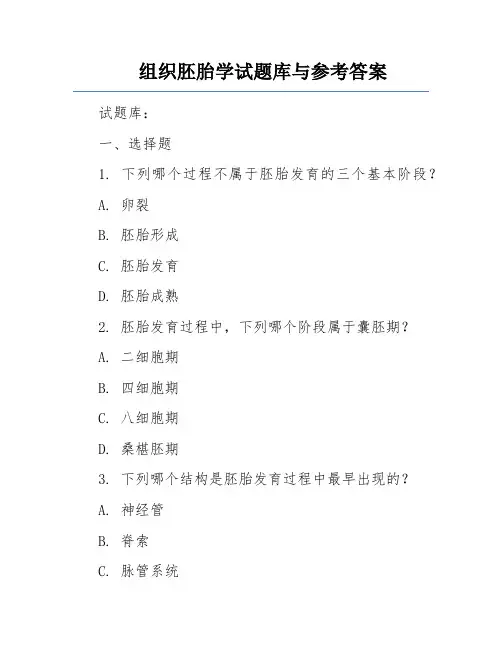
组织胚胎学试题库与参考答案试题库:一、选择题1. 下列哪个过程不属于胚胎发育的三个基本阶段?A. 卵裂B. 胚胎形成C. 胚胎发育D. 胚胎成熟2. 胚胎发育过程中,下列哪个阶段属于囊胚期?A. 二细胞期B. 四细胞期C. 八细胞期D. 桑椹胚期3. 下列哪个结构是胚胎发育过程中最早出现的?A. 神经管B. 脊索C. 脉管系统D. 肌肉组织4. 胚胎发育过程中,下列哪个器官系统发育最早?A. 神经系统B. 循环系统C. 消化系统D. 呼吸系统5. 下列哪个过程不属于胚胎发育过程中的细胞分化?A. 胚层形成B. 细胞增殖C. 细胞迁移D. 细胞凋亡二、填空题6. 胚胎发育的三个基本阶段是______、______和______。
7. 胚胎发育过程中,囊胚期是指______细胞期的胚胎。
8. 胚胎发育过程中,胚胎层的形成包括______、______和______。
9. 胚胎发育过程中,细胞凋亡对胚胎发育具有______作用。
10. 胚胎发育过程中,下列器官系统发育顺序为:______、______、______。
三、判断题11. 胚胎发育过程中,细胞分化是不可逆的。
()12. 胚胎发育过程中,细胞增殖和细胞凋亡是相互独立的。
()13. 胚胎发育过程中,胚胎层的形成是胚胎发育的关键时期。
()14. 胚胎发育过程中,神经系统的发育晚于循环系统。
()15. 胚胎发育过程中,细胞迁移对胚胎形态建成具有重要作用。
()参考答案:一、选择题1. D2. D3. B4. B5. B二、填空题6. 卵裂胚胎形成胚胎发育7. 八细胞期8. 外胚层内胚层中胚层9. 调节作用10. 循环系统神经系统消化系统三、判断题11. √12. ×13. √14. ×15. √旨在帮助学习者巩固基础知识,提高对胚胎发育过程的理解。
通过这些试题,学习者可以更好地掌握组织胚胎学的基本概念、发育过程和发育机制,为后续研究奠定基础。
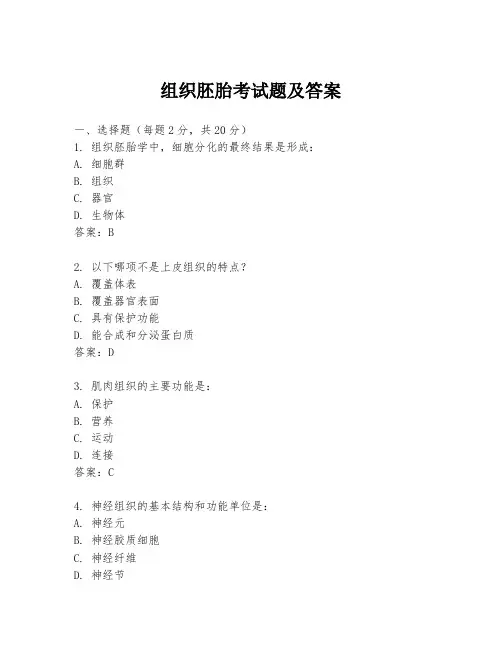
组织胚胎考试题及答案一、选择题(每题2分,共20分)1. 组织胚胎学中,细胞分化的最终结果是形成:A. 细胞群B. 组织C. 器官D. 生物体答案:B2. 以下哪项不是上皮组织的特点?A. 覆盖体表B. 覆盖器官表面C. 具有保护功能D. 能合成和分泌蛋白质答案:D3. 肌肉组织的主要功能是:A. 保护B. 营养C. 运动D. 连接答案:C4. 神经组织的基本结构和功能单位是:A. 神经元B. 神经胶质细胞C. 神经纤维D. 神经节5. 以下哪项不是结缔组织的功能?A. 连接B. 支持C. 保护D. 运动答案:D6. 胚胎发育过程中,原肠形成后,胚胎的体轴分为:A. 前-后轴B. 头-尾轴C. 背-腹轴D. 左-右轴答案:B7. 胚胎期心脏发育的起始结构是:A. 心管B. 心球C. 心室D. 心房答案:A8. 胚胎发育中,神经管的闭合通常发生在:A. 第2周B. 第3周C. 第4周D. 第5周答案:C9. 以下哪项不是胚胎期肢芽发育的结果?B. 四肢C. 脊柱D. 手指和脚趾答案:C10. 胚胎期,以下哪项是形成面部的主要结构?A. 鳃弓B. 鳃裂C. 神经嵴D. 神经管答案:A二、填空题(每空1分,共10分)1. 组织胚胎学研究的内容包括细胞、______、器官的发生、发展和功能。
答案:组织2. 胚胎发育的早期阶段,______是形成胚胎体轴和左右对称性的基础。
答案:原肠3. 在胚胎发育过程中,______的形成标志着胚胎体轴的确立。
答案:脊索4. 神经管的闭合不完全可能导致______。
答案:神经管缺陷5. 胚胎期,心脏发育过程中,心球分化为______和心室。
答案:心房三、简答题(每题10分,共20分)1. 简述胚胎发育中胚层的形成及其功能。
答案:胚胎发育中,胚层的形成包括外胚层、中胚层和内胚层。
外胚层主要形成神经系统和表皮,中胚层分化为肌肉、骨骼和循环系统,内胚层则形成消化道和呼吸系统的上皮。
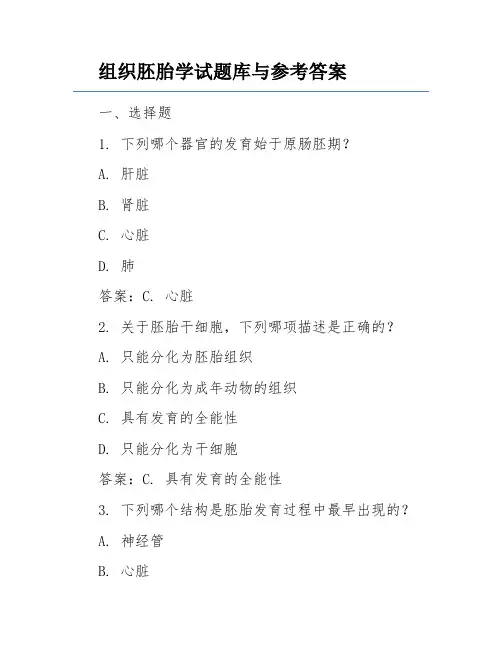
组织胚胎学试题库与参考答案一、选择题1. 下列哪个器官的发育始于原肠胚期?A. 肝脏B. 肾脏C. 心脏D. 肺答案:C. 心脏2. 关于胚胎干细胞,下列哪项描述是正确的?A. 只能分化为胚胎组织B. 只能分化为成年动物的组织C. 具有发育的全能性D. 只能分化为干细胞答案:C. 具有发育的全能性3. 下列哪个结构是胚胎发育过程中最早出现的?A. 神经管B. 心脏C. 肝脏D. 肾脏答案:A. 神经管4. 下列哪个因素不是导致胚胎发育异常的主要原因?A. 遗传因素B. 环境因素C. 药物因素D. 营养因素答案:D. 营养因素5. 下列哪个时期是胚胎发育最关键的时期?A. 囊胚期B. 原肠胚期C. 胚层期D. 胎儿期答案:B. 原肠胚期6. 下列哪个激素与性别决定的形成有关?A. 睾酮B. 雌激素C. 生长激素D. 糖皮质激素答案:A. 睾酮7. 下列哪个结构是哺乳动物胚胎发育过程中特有的?A. 神经管B. 鳃裂C. 尾芽D. 尿囊答案:D. 尿囊8. 下列哪个过程不是胚胎发育的基本过程?A. 细胞分裂B. 细胞分化C. 细胞迁移D. 细胞凋亡答案:D. 细胞凋亡9. 下列哪个器官的发育受遗传因素影响最大?A. 肝脏B. 肾脏C. 心脏D. 肺答案:C. 心脏10. 下列哪个时期是胚胎器官发生的关键时期?A. 囊胚期B. 原肠胚期C. 胚层期D. 胎儿期答案:B. 原肠胚期二、填空题1. 胚胎发育过程主要包括______、______、______、______四个时期。
答案:卵裂期、囊胚期、原肠胚期、胎儿期2. 哺乳动物胚胎发育过程中,______是胚胎发育的基本过程。
答案:细胞分裂、细胞分化、细胞迁移3. 胚胎干细胞来源于______,具有______。
答案:早期胚胎或原始性腺,发育的全能性4. 哺乳动物胚胎发育过程中,______是导致胚胎发育异常的主要原因。
答案:遗传因素、环境因素、药物因素5. 胚胎发育过程中,______是胚胎发育最关键的时期。
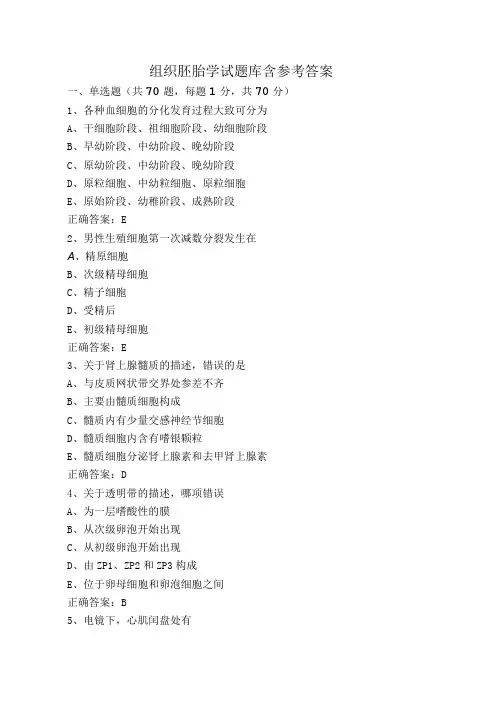
组织胚胎学试题库含参考答案一、单选题(共70题,每题1分,共70分)1、各种血细胞的分化发育过程大致可分为A、干细胞阶段、祖细胞阶段、幼细胞阶段B、早幼阶段、中幼阶段、晚幼阶段C、原幼阶段、中幼阶段、晚幼阶段D、原粒细胞、中幼粒细胞、原粒细胞E、原始阶段、幼稚阶段、成熟阶段正确答案:E2、男性生殖细胞第一次减数分裂发生在A、精原细胞B、次级精母细胞C、精子细胞D、受精后E、初级精母细胞正确答案:E3、关于肾上腺髓质的描述,错误的是A、与皮质网状带交界处参差不齐B、主要由髓质细胞构成C、髓质内有少量交感神经节细胞D、髓质细胞内含有嗜银颗粒E、髓质细胞分泌肾上腺素和去甲肾上腺素正确答案:D4、关于透明带的描述,哪项错误A、为一层嗜酸性的膜B、从次级卵泡开始出现C、从初级卵泡开始出现D、由ZP1、ZP2和ZP3构成E、位于卵母细胞和卵泡细胞之间正确答案:B5、电镜下,心肌闰盘处有A、中间连接、桥粒、紧密连接B、中间连接、桥粒、缝隙连接C、紧密连接、桥粒、缝隙连接D、连接复合体、桥粒、紧密连接E、以上都不对正确答案:B6、关于复层扁平上皮的描述,哪项错误?A、中层细胞多边形,细胞间隙内具有毛细血管B、细胞层次多,浅层细胞扁平并不断脱落C、有的形成角化层D、基底层细胞幼稚,具有旺盛的分裂能力E、上皮与结缔组织的接触面多凹凸不平正确答案:A7、气管上皮中能增殖分化的细胞是A、基细胞B、纤毛细胞C、杯状细胞D、刷细胞E、小颗粒细胞正确答案:A8、心脏是心血管系统的泵器官,其管壁结构分为A、心内皮、内皮下层、内弹性膜、心中膜和心外膜B、心内皮、内皮下层、心肌膜和心外膜C、心内膜、心内膜下层、心肌层和心外膜D、心内膜、心中膜、心外膜和心瓣膜E、心内膜、心肌膜和心外膜正确答案:E9、血-胸腺屏障不包括A、毛细血管基膜B、胸腺细胞间的紧密连接C、血管周隙及其中的巨噬细胞D、连续的上皮基膜E、上皮细胞突起正确答案:B10、球旁细胞是指A、入球微动脉行至近肾小体血管极处管壁上的内皮细胞转变而来B、血管球处的系膜细胞C、出球微动脉行至近肾小体血管极处管壁上的平滑肌细胞转变而来D、入球微动脉行至近肾小体血管极处管壁上的平滑肌细胞转变而来E、出球微动脉行至近肾小体血管极处管壁上的内皮细胞转变而来正确答案:D11、不是近曲小管特点的选项是A、胞体大,胞质嗜酸性B、管壁上皮细胞分界较清晰C、上皮细胞腔面有刷状缘,基部有纵纹D、上皮细胞呈立方形或锥形E、核圆,位于近基部正确答案:B12、下列哪种蛋白不参与组成细肌丝A^肌动蛋白Bs原肌球蛋白C、肌球蛋白D、肌钙蛋白E、以上都不对正确答案:C13、关于胶原纤维,哪项错误?A、主要由成纤维细胞产生,又称白纤维B、HE染色不易着色C、结缔组织中数量最多D、由大量胶原原纤维构成E、韧性强正确答案:B14、气管壁的3层结构是A、黏膜、肌层和纤维膜B、黏膜、肌层和浆膜C、内膜、中膜和外膜D、黏膜、黏膜下层和外膜E、黏膜、黏膜下层和肌膜正确答案:D15、脾内的细胞免疫应答发生在A、脾淋巴小结B、脾血窦C、边缘窦D、脾索E、动脉周围淋巴鞘正确答案:E16、关于胸腺,哪项错误A^胸腺小体仅分布于髓质B、胸腺小体由胸腺细胞呈同心圆排列而成C、与皮质相比,髓质内的T细胞较少D、胸腺细胞增殖分化成T细胞E、是培育T细胞的中枢淋巴器官正确答案:B17、不属于肺呼吸部的是A、终末细支气管B、呼吸性细支气管C、肺泡管D、肺泡E、肺泡囊正确答案:A18、血一胸腺屏障的血管周隙中含有A、周细胞B、T淋巴细胞C、巨噬细胞D、B淋巴细胞E、NK细胞正确答案:C19、淋巴结副皮质区A、在被膜下,主要含T细胞B、在皮质浅部,主要含B细胞C、在皮质深部,主要含T细胞D、在髓质浅部,主要含B细胞E、在髓质深部,主要含T细胞正确答案:C20、肺内各级支气管中,管壁内形成明显环形平滑肌层的是A、细支气管和呼吸性细支气管B、终末细支气管C、叶支气管和段支气管D、小支气管和呼吸性细支气管E、细支气管和终末细支气管正确答案:E21、内、中、外三个胚层都来源于A、下胚层B、胚外中胚层C、胚内中胚层D、上胚层E、滋养层正确答案:D22、直接与子宫内膜接触的结构是A、羊膜B、尿囊C、卵黄囊D、胚盘E、滋养层正确答案:E23、关于脾血窦的结构特征,错误的是A、窦壁由扁平的内皮细胞围成B、内皮间有较明显的细胞间隙,基膜不完整C、窦壁由长杆状内皮细胞围成D、血窦周围有许多巨噬细胞E、位于脾索之间,形状不规则正确答案:A24、脊索的细胞来源于A、蜕膜B、脊髓C、体蒂D、原凹E、原沟正确答案:D25、下列哪种细胞可转化为巨噬细胞A、嗜酸性粒细胞B、嗜碱性粒细胞C、中性粒细胞D、单核细胞E、淋巴细胞正确答案:D26、前置胎盘的原因是A、胎盘发育过大B、胚胎植入子宫底部C、胚胎植入输卵管壶腹部D、胚胎植入近子宫颈内口处E、胚胎植入近输卵管开口处正确答案:D27、肺的呼吸部指A、小支气管至肺泡B、呼吸性细支气管至肺泡C、肺泡管至肺泡D、所有肺泡E、终末细支气管至肺泡正确答案:B28、有关肺泡隔的错误选项A、是相邻肺泡之间的薄层结缔组织B、其内有密集的有孔毛细血管C、有丰富的弹性纤维D、弹性纤维有回缩肺泡的作用E、吸烟可加速弹性纤维退化进程正确答案:B29、关于腺垂体嗜碱性细胞的描述,哪项错误A、分泌促肾上腺髓质激素B、分泌卵泡刺激素C、分泌促甲状腺激素D、细胞质中含有嗜碱性颗粒E、分泌间质细胞刺激素正确答案:A30、网织红细胞内含有的细胞器是A、溶酶体B、核糖体C、线粒体D、细胞核E、高尔基复合体正确答案:B31、胰腺中哪种细胞退化可引起糖尿病?A、A细胞B、B细胞C、D细胞D、PP细胞E、浆液性腺细胞正确答案:B32、关于睾丸的描述,哪项错误A、表面覆以浆膜B、睾丸实质由200-300个锥形小叶组成C、生精小管之间的疏松结缔组织称为睾丸间质D、内存在大量生精小管E、生精小管进入睾丸纵隔形成睾丸网正确答案:E33、关于终末细支气管的结构,哪项错误A、无杯状细胞B、平滑肌形成完整的环形层C、上皮为单层柱状D、管壁内透明软骨片少E、无腺体正确答案:D34、附睾内的结构包括A、附睾管、直精小管B、输出小管、生精小管C、直精小管、睾丸网D、附睾管、输出小管E、输出小管、睾丸网正确答案:D35、关于肺泡哪项错误?A、是肺进行气体交换的场所B、∏型肺泡细胞分泌表面活性物质C、相邻两个肺泡间的薄层结缔组织为肺泡隔D、上皮由I型与∏型肺泡细胞构成E、肺泡隔内有丰富的有孔毛细血管正确答案:E36、关于腺垂体的描述,哪项错误A、远侧部细胞分泌激素的种类多B、分为远侧部、中间部、结节部C、嗜酸性细胞少,嗜碱性细胞多D、由嗜色细胞和嫌色细胞组成E、远侧部占垂体大部分正确答案:C37、受精过程中不发生A、顶体反应B、卵母细胞的第二次减数分裂C、透明带反应D、蜕膜反应E、精卵细胞膜融合正确答案:D38、关于成纤维细胞的形态,哪项错误?A、多突起B、胞核大,核仁明显C、电镜下粗面内质网较发达D、无明显分泌颗粒E、胞质呈嗜酸性正确答案:E39、合成和分泌免疫球蛋白的细胞是A、浆细胞B、肥大细胞C、淋巴细胞D、巨噬细胞E、成纤维细胞正确答案:A40、正常妊娠至分娩的羊水量是A、500以下B、 500-1000mlC、 1000-1500mlD、 1500-2000mlE、 2000-2500ml正确答案:C41、有关肾实质的描述哪项是错误的A、肾锥体之间的皮质称皮质迷路B、皮质在浅层C、分为皮质和髓质D、髓质为十几个肾锥体E、一个肾锥体与相连的皮质组成肾叶正确答案:A42、肺导气部的最末段是A、呼吸性细支气管B、肺泡管C、细支气管D、小支气管E、终末细支气管正确答案:E43、精子的主要运动装置是A、线粒体鞘B、外周致密纤维C、纤维鞘D、轴丝E、顶体正确答案:D44、呆小症是因为A、性激素分泌不足所造成B、降钙素分泌不足所造成C、甲状旁腺激素分泌不足所造成D、生长激素分泌不足所造成E、甲状腺激素分泌不足所造成正确答案:E45、下丘脑调节腺垂体的主要方式是A、胆碱能神经调节B、分泌释放激素或抑制激素调节C、正反馈方式调节D、交感神经调节E、副交感神经调节正确答案:B46、血液内淋巴细胞进入淋巴组织的通道是A、毛细血管后微静脉B、动脉周围淋巴鞘C、边缘窦D、脾窦E、淋巴窦正确答案:A47、内膜与中膜分界明显的血管是A、中动脉B、大动脉C、小静脉D、中静脉E、大静脉正确答案:A48、直接使子宫内膜发生月经周期变化的激素是A、雄激素B、黄体生成素C、卵泡刺激素D、雌激素和孕激素E、松弛素正确答案:D49、巨噬细胞来源于A、中性粒细胞B、网状细胞C、巨核细胞D、内皮细胞E、单核细胞正确答案:E50、关于肺泡,下列哪项错误A、II型肺泡细胞胞质含有嗜钺性板层小体B、I型肺泡细胞细胞器不发达,吞饮小泡多C、肺泡表面绝大部分衬以II型肺泡细胞D、口型肺泡细胞有增殖分化能力E、相邻肺泡之间有小孔相通正确答案:C51、肾小体位于A、皮质迷路和肾柱B、皮质迷路和髓放线C、皮质迷路D、肾柱和肾锥体E、肾锥体正确答案:A52、关于浦肯野纤维的描述,错误是?A、闰盘发达B、含肌原纤维少C、功能是传导兴奋D、是神经纤维E、是心肌纤维正确答案:D53、外胚层分化的结构有A、神经组织B、消化系统C、结缔组织D、心包腔E、皮肤的真皮层正确答案:A54、气管上皮中,游离面有许多长而直的微绒毛的细胞是A、纤毛细胞B、杯状细胞C、刷细胞D、小颗粒细胞E、基细胞正确答案:C55、心血管系统各段管壁的共有成分是A、内弹性膜B、内皮C、间皮D、平滑肌E、外弹性膜正确答案:B56、下列不属于胃底腺细胞的是A、颈黏液细胞B、潘氏细胞C、内分泌细胞D、壁细胞E、主细胞正确答案:B57、血-睾屏障的组成不包括如下A、各级生精细胞B、支持细胞间的紧密连接C、结缔组织D、毛细血管内皮及基膜E、生精上皮的基膜正确答案:A58、关于光镜下神经元的特征哪项错误A、细胞形态多种多样,均有突起B、由胞体、树突和轴突组成C、核大而圆,核仁明显D、胞体及突起内都有神经原纤维E、细胞质内除一般细胞器外,还富含尼氏体和神经纤维两种特征性的结构正确答案:E59、在正常情况下,可以通过肾小体滤过膜的物质是A、血浆成分B、除大分子蛋白质以外的血浆成分C、少量红细胞和血浆成分D、除葡萄糖、氨基酸以外的血浆成分E、除多肽、尿素等以外的血浆成分正确答案:B60、演变为胚内体腔的胚层结构是A、轴旁中胚层B、外胚层C、侧中胚层D、间介中胚层E、内胚层正确答案:C61、构成周围淋巴组织细支架的是A、上皮性网状细胞B、网状纤维C、小梁D、网状组织E、网状细胞正确答案:D62、关于肝血窦的描述,错误的是?A、内皮细胞体有孔B、血窦内血液汇入中央静脉C、内皮细胞之间有较大间隙D、形态不规则E、有完整的基膜正确答案:E63、对消化管皱嬖形成的正确描述是A、上皮、固有层和黏膜肌层突向管腔B、上皮和固有层突向管腔C、黏膜和黏膜下层突向管腔D、上皮突向管腔E、黏膜、黏膜下层和肌层突向管腔正确答案:C64、构成雕板的是A、密质骨B、透明软骨C、松质骨D、弹性软骨E、类骨质正确答案:B65、浆液性细胞核的最主要形态特点是A、核为圆形,位于细胞中央B、核为扁圆形,位于细胞中央C、核为圆形,位于细胞偏基底部D、核在细胞的顶部E、核为扁圆形,位于细胞偏基底部正确答案:C66、使心肌整体的收缩和舒张同步化主要依靠于A、二联体B、肌浆网C、缝隙连接D、中间连接E、T小管正确答案:C67、关于纤毛的叙述,哪项错误A、光镜下无法辨认B、具有定向摆动的能力C、内含两条中央微管D、内含9组双联微管E、分布于细胞游离面正确答案:A68、Clara细胞能分泌Λ^ 5-羟色胺B、蛋白酶C、黏液D、表面活性物质E、磷酯及黏多糖正确答案:B69、关于小肠绒毛固有层,描述错误的是?A、不含平滑肌B、含中央乳糜管C、乳糜微粒入中央乳糜管D、含丰富的毛细血管E、吸收的氨基酸和单糖入毛细血管正确答案:A70、食管的组织结构特点不包括?A、肌层为纵行的平滑肌B、黏膜下层含食管腺C、上、下端固有层可有少许黏液性腺D、黏膜上皮为复层扁平上皮E、外膜为纤维膜正确答案:A二、多选题(共20题,每题1分,共20分)1、存在于消化管固有层内的腺体有A、十二指肠腺B、贲门腺C、胃底腺D、食管腺E、肠腺正确答案:BCE2、垂体神经部A、经漏斗与下丘脑相连B、有大量无髓神经纤维和赫令体C、有神经胶质细胞D、有窦状毛细血管E、有有孔毛细血管正确答案:ABCE3、下列关于胎盘膜(胎盘屏障)的描述,正确的是A、位于母体血和胎儿血之间B、早期由合体滋养层、细胞滋养层和基膜等结构组成C、随着妊娠的进程逐渐变薄D、由胎儿的丛密绒毛膜和母体的基蜕膜组成E、胎盘膜阻止所有物质通行正确答案:ABC4、属于心传导系统的细胞是A、心室肌细胞B、移行细胞C、起搏细胞D、浦肯野纤维E、心房肌细胞正确答案:BCD5、下列器官含有淋巴小结的是A、骨髓B、胸腺C、淋巴结D、扁桃体E、脾正确答案:CDE6、甲状旁腺A、嗜酸性细胞功能不明B、腺细胞排列成滤泡C、腺细胞分主细胞和嗜酸性细胞D、嗜酸性细胞分泌生长激素E、主细胞分泌甲状旁腺激素正确答案:ACE7、胎膜包括A、胎盘B、绒毛膜C、脐带D、羊膜E、蜕膜正确答案:BCD8、三胚层包括A、中胚层B、上胚层C、外胚层D、内胚层E、下胚层正确答案:ACD9、肾上腺皮质的结构特点是A、束状带最厚B、由表及里分为球状带、束状带和网状带C、三个带之间并无截然的界限D、腺细胞有类固醇激素分泌细胞的超微结构特点E、有丰富的血窦正确答案:ABCDE10、关于毛细血管的描述,正确的是A、管径最细的血管B、是血液与组织细胞进行物质交换的主要部位C、在体内分布最广D、在各器官内的疏密程度大致相同E、由内皮和基膜组成正确答案:ABCE11、抗原提呈细胞有A、巨噬细胞B、树突状细胞C、B细胞D、面纱细胞E、朗格汉斯细胞正确答案:ABCDE12、组成骨骼肌纤维细肌丝的蛋白质是A、肌动蛋白B、肌红蛋白C、肌球蛋白Ds原肌球蛋白E、肌钙蛋白正确答案:ADE13、与扩大小肠的表面积有关的结构是A、环形皱裳B、小肠腺C、微绒毛D、小肠绒毛E、杯状细胞正确答案:ACD 14、精子细胞变态形成精子的过程正确的是A、线粒体聚集形成线粒体鞘B、中心体形成轴丝C、滑面内质网形成顶体D、核染色质浓缩形成精子头部E、残余的胞质被巨噬细胞消灭正确答案:ABD15、巨人症与肢端肥大症A、均出现在幼年时期,去病因后可恢复正常B、均与生长激素分泌过多有关C、均因骨细胞受刺激而增殖过速而致D、与腺垂体嗜酸性细胞增生或功能亢进有关E、均出现在成年时期,去病因后可恢复正常正确答案:BD16、脾血窦的特征是A、内皮细胞有较多窗孔B、内皮外侧巨噬细胞较多C、内皮下有完整的基膜D、内皮细胞间隙大E、内皮细胞呈杆状正确答案:ABDE17、睾丸的主要功能是A、分泌雄性激素B、产生精子C、分泌雌激素E形成精液D、促进精子成熟正确答案:AD18、属于感觉神经末梢的是A、触觉小体B、环层小体C、游离神经末梢D、肌梭E、运动终板正确答案:ABCD19、窦周隙内有A、肝巨噬细胞B、血浆C、肝细胞微绒毛D、贮脂细胞E、网状纤维正确答案:BCDE20、除了常规的石蜡切片法,下列哪些亦属于组织学的制片方法A、涂片法B、磨片法C、铺片法D、冷冻切面法E、煮片法正确答案:ABCD三、判断题(共10题,每题1分,共10分)1、子宫颈粘膜不会发生周期性剥脱,但分泌性质受卵巢激素的影响。
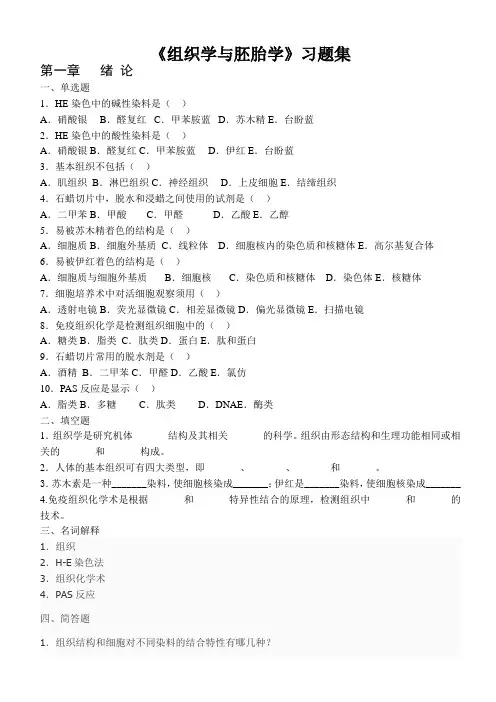
《组织学与胚胎学》习题集第一章绪论一、单选题1.HE染色中的碱性染料是()A.硝酸银 B.醛复红 C.甲苯胺蓝 D.苏木精E.台盼蓝2.HE染色中的酸性染料是()A.硝酸银B.醛复红C.甲苯胺蓝 D.伊红E.台盼蓝3.基本组织不包括()A.肌组织B.淋巴组织C.神经组织 D.上皮细胞E.结缔组织4.石蜡切片中,脱水和浸蜡之间使用的试剂是()A.二甲苯B.甲酸C.甲醛D.乙酸 E.乙醇5.易被苏木精着色的结构是()A.细胞质B.细胞外基质C.线粒体D.细胞核内的染色质和核糖体E.高尔基复合体6.易被伊红着色的结构是()A.细胞质与细胞外基质B.细胞核C.染色质和核糖体D.染色体E.核糖体7.细胞培养术中对活细胞观察须用()A.透射电镜B.荧光显微镜C.相差显微镜D.偏光显微镜 E.扫描电镜8.免疫组织化学是检测组织细胞中的()A.糖类B.脂类C.肽类D.蛋白E.肽和蛋白9.石蜡切片常用的脱水剂是()A.酒精B.二甲苯C.甲醛 D.乙酸 E.氯仿10.PAS反应是显示()A.脂类B.多糖C.肽类D.DNAE.酶类二、填空题1.组织学是研究机体_______结构及其相关_______的科学。
组织由形态结构和生理功能相同或相关的_______和_______构成。
2.人体的基本组织可有四大类型,即_______、_______、_______和_______。
3.苏木素是一种_______染料,使细胞核染成_______;伊红是_______染料,使细胞核染成_______ 4.免疫组织化学术是根据_______和_______特异性结合的原理,检测组织中_______和_______的技术。
三、名词解释1.组织2.H-E染色法3.组织化学术4.PAS反应四、简答题1.组织结构和细胞对不同染料的结合特性有哪几种?2.与光镜术比较,透射电镜技术的主要特点有哪些?五、论述题1.说明免疫组织化学技术检测组织和细胞内蛋白质抗原的基本原理和关键技术。
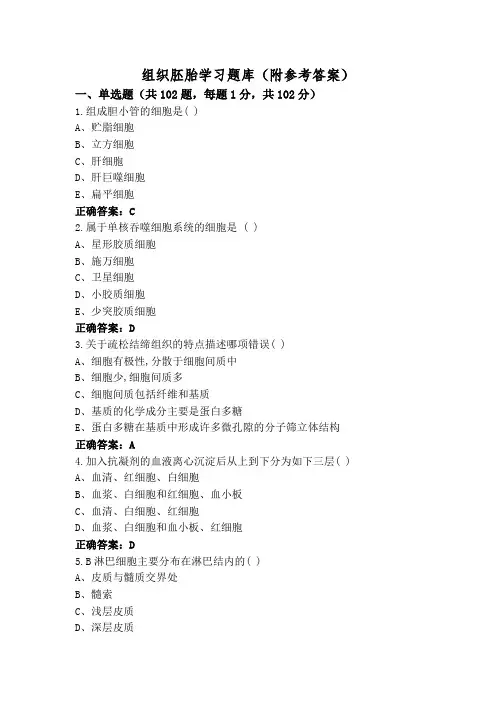
组织胚胎学习题库(附参考答案)一、单选题(共102题,每题1分,共102分)1.组成胆小管的细胞是( )A、贮脂细胞B、立方细胞C、肝细胞D、肝巨噬细胞E、扁平细胞正确答案:C2.属于单核吞噬细胞系统的细胞是 ( )A、星形胶质细胞B、施万细胞C、卫星细胞D、小胶质细胞E、少突胶质细胞正确答案:D3.关于疏松结缔组织的特点描述哪项错误( )A、细胞有极性,分散于细胞间质中B、细胞少,细胞间质多C、细胞间质包括纤维和基质D、基质的化学成分主要是蛋白多糖E、蛋白多糖在基质中形成许多微孔隙的分子筛立体结构正确答案:A4.加入抗凝剂的血液离心沉淀后从上到下分为如下三层( )A、血清、红细胞、白细胞B、血浆、白细胞和红细胞、血小板C、血清、白细胞、红细胞D、血浆、白细胞和血小板、红细胞正确答案:D5.B淋巴细胞主要分布在淋巴结内的( )A、皮质与髓质交界处B、髓索C、浅层皮质D、深层皮质6.组织液来源于( )A、毛细血管B、毛细血管动脉端C、毛细淋巴管盲端D、毛细淋巴管E、毛细血管静脉端正确答案:B7.关于透明带的功能哪项正确( )A、进化过程的产物,无功能意义B、分割卵泡细胞和卵母细胞的作用C、卵泡细胞通过透明带给卵母细胞提供营养D、保护中间的卵母细胞正确答案:C8.具有合成和分泌抗体功能的细胞是 ( )A、成纤维细胞B、脂肪细胞C、巨噬细胞D、肥大细胞E、浆细胞正确答案:E9.下列哪一项不属于固有结缔组织的是( )A、致密结缔组织B、淋巴组织C、脂肪组织D、网状组织E、疏松结缔组织正确答案:B10.具有吞噬功能的神经胶质细胞是( )A、少突胶质细胞B、星形胶质细胞C、室管膜细胞D、施万细胞E、小胶质细胞11.人体结构和功能的基本单位是 ( )A、组织B、系统C、细胞D、大分子E、器官正确答案:C12.关于胰岛的描述哪项错误( )A、胰头和胰体较少B、大小不等C、胰尾中胰岛最多D、胰头部最多E、胰岛是腺泡之间的细胞团正确答案:D13.小脑皮质颗粒层内的神经元有( )A、颗粒细胞和高尔基细胞B、高尔基细胞和篮状细胞C、高尔基细胞和星形细胞D、颗粒细胞和星形细胞E、篮状细胞和星形细胞正确答案:A14.毛细血管分类的依据是( )A、毛细血管的光镜结构B、毛细血管的电镜结构C、内皮细胞的光镜结构D、内皮细胞的电镜结构E、毛细血管的所有结构特点正确答案:D15.有关破骨细胞的结构和功能,哪一点是错误的?( )A、含有一个巨大的细胞核B、胞质含许多溶酶体和吞噬泡C、细胞大,胞质嗜酸性D、接触骨基质的细胞表面有皱褶缘E、属于单核吞噬细胞系统正确答案:A16.关于肺泡的结构特征哪项错误( )A、相邻肺泡之间的组织称为肺泡隔B、肺泡上皮细胞由I型和II型两种细胞组成C、相邻肺泡之间经肺泡孔相通D、肺泡隔中有平滑肌和毛细血管网正确答案:D17.关于睾丸支持细胞的描述哪项错误( )A、单层柱状细胞,轮廓清晰可辨B、核不规则形C、细胞基部紧贴基膜D、相邻支持细胞基底侧有紧密连接正确答案:A18.关于肾小囊的描述哪项错误( )A、肾小囊的内层细胞为足细胞B、肾小囊内层不参与滤过膜的构成C、肾小囊的外层上皮为单层扁平上皮D、是近端小管起始盲端凹陷而成的双层杯状结构正确答案:B19.关于乳腺的描述,下列哪项正确( )A、复管泡状腺B、实质由腺叶组成,每一腺叶由分泌部和导管部组成C、静止期乳腺主要是间质组织,乳腺的腺泡很少D、泌乳期乳腺腺泡发达,间质少E、以上都对正确答案:E20.关于中性粒细胞的描述哪项错误( )A、核为圆形B、细胞呈球形C、能做变形运动并有吞噬功能D、胞质内特殊颗粒含碱性磷酸酶、吞噬素和溶菌酶正确答案:A21.分布在真皮的组织( )A、是不规则的致密结缔组织B、是规则的致密结缔组织C、以弹性纤维为主的组织D、细胞平行排列在纤维之间E、是致密结缔组织正确答案:A22.动脉中膜内不含有( )A、弹性纤维B、平滑肌纤维C、营养血管D、成纤维细胞E、胶原纤维正确答案:D23.骨细胞( )A、相邻骨细胞的突起以桥粒相连B、多突起,但不位于骨小管中C、不能由骨祖细胞分裂分化而来D、胞体位于骨陷窝中E、对骨质的更新有重要作用,但骨质维持无作用正确答案:D24.内皮细胞的特性结构是( )A、发达的高尔基复合体B、丰富的溶酶体C、细胞间有10--20nm的间隙D、丰富的紧密连接E、W-P小体正确答案:E25.化学突触内与神经冲动传递直接相关的结构是( )A、微丝B、微管C、线粒体D、神经丝E、突触小泡正确答案:E26.杯状细胞常见于( )A、单层扁平上皮B、单层柱状上皮C、复层扁平上皮D、单层立方上皮E、变移上皮正确答案:B27.肺的结构单位是( )A、肺泡B、肺的呼吸部C、肺小叶D、肺叶正确答案:C28.组成胃底腺的细胞有( )A、主细胞、壁细胞、颈粘液细胞和潘氏细胞B、主细胞、壁细胞、杯状细胞和内分泌细胞C、主细胞、壁细胞、干细胞、颈粘液细胞和内分泌细胞D、主细胞、壁细胞、杯状细胞、颈粘液细胞和内分泌细胞正确答案:C29.关于单核细胞的描述哪项错误( )A、血液中体积最大的细胞B、起源于淋巴器官C、是组织中巨噬细胞的前身D、嗜天青颗粒含过氧化物酶正确答案:B30.关于M细胞的描述哪项错误( )A、透射电镜下,M细胞胞质的电子密度较吸收细胞低B、M细胞与相邻的细胞间有紧密连接、中间连接和桥粒C、M细胞基部向上凹入形成中央腔,腔内可见淋巴细胞D、M细胞分泌抗体A正确答案:D31.下列哪种细胞不存在于呼吸道的粘膜上皮中( )A、纤毛细胞B、杯状细胞C、基细胞D、刷细胞E、颈粘液细胞正确答案:E32.下列哪种上皮游离面可见纤毛( )A、支气管上皮B、肠上皮C、输尿管上皮D、远曲小管上皮E、胆囊上皮正确答案:A33.胞质内有异染性颗粒并可脱颗粒引发过敏的细胞是( )A、肥大细胞B、成纤维细胞C、单核细胞D、脂肪细胞E、浆细胞正确答案:A34.分布于呼吸道的上皮组织属于 ( )A、复层柱状上皮B、单层立方上皮C、假复层纤毛柱状上皮D、单层柱状上皮E、单层扁平上皮正确答案:C35.光镜下,小肠区别于大肠的最重要特征是( )A、有许多皱劈B、有许多肠绒毛C、肠腺较短小D、无结肠带E、杯状细胞较少正确答案:B36.中枢神经系统的髓鞘形成细胞是 ( )A、室管膜细胞B、纤维性星形胶质细胞C、小胶质细胞D、原浆性星形胶质细胞E、少突胶质细胞正确答案:B37.关于变移上皮的描述哪项正确( )A、厚度不变B、表层细胞常有角化C、基底面凹凸不平D、表层细胞呈扁平状E、细胞层数和形状可发生变化正确答案:E38.下列纤维,何种纤维是细胞间质( )A、神经原纤维B、胶原纤维C、肌纤维D、神经纤维E、肌原纤维正确答案:B39.平滑肌纤维的中间丝起( )A、收缩作用B、连接作用C、保护作用D、滑动作用E、骨架作用正确答案:E40.关于骨骼肌纤维的三联体,下列叙述不正确的是( )A、由一个T小管与两侧的终池组成B、横小管与肌膜相连续C、光镜下可见D、其作用是将兴奋传到肌质网E、终池的膜上有钙泵正确答案:C41.关于心脏传导系统的描述哪项错误( )A、心脏传导系统由特殊的心肌纤维形成B、心脏传导系统包括窦房结、房室结、房室束及其束支C、心脏传导系统均位于心内膜下层D、心脏传导系统的功能是协调心房和心室按一定节律收缩正确答案:C42.心肌纤维彼此相连形成功能性整体是靠( )A、闰盘B、肌丝C、二联体D、肌浆网E、T小管正确答案:A43.与动脉相比,静脉不具有的特点是( )A、三层膜分界明显B、血容量比动脉大C、管壁结构差异较大D、管壁含平滑肌和弹性组织较少E、管壁较薄,结缔组织成分较多正确答案:A44.内分泌腺中能将合成的分泌物贮存在滤泡腔内的腺体是( )A、甲状旁腺B、胰岛C、甲状腺D、肾上腺E、松果体正确答案:C45.多数哺乳动物排卵时卵母细胞处于( )A、卵原细胞时期B、初级卵母细胞,第一次成熟分裂前期C、次级卵母细胞,第二次成熟分裂前期D、次级卵母细胞,第二次成熟分裂中期E、以上都不是正确答案:D46.下列选项中不属于上皮组织的基本特点的是: ( )A、细胞形态比较规则B、细胞有明显极性C、有丰富的毛细血管D、细胞排列紧密E、极少的细胞间质正确答案:C47.心脏的传导系统是指( )A、心脏内神经纤维组成的一个系统B、心脏内心肌纤维借闰盘相连,胞质经缝隙连接相互连通而形成的一个整体C、特殊心肌纤维形成的一个系统D、将血液由静脉系泵到动脉系的传导系E、以上均不对正确答案:C48.胃底腺壁细胞的特点是 ( )A、细胞呈圆锥形,胞质强嗜酸性B、细胞内分泌小管与盐酸的形成有关C、细胞内微管泡系统是细胞内分泌小管的储备形式D、有丰富的线粒体E、以上选项全对正确答案:B49.关于大肠的描述哪项错误 ( )A、粘膜上皮有纹状缘B、大肠腺无潘氏细胞C、大肠腺上皮杯状细胞多D、缺乏肠绒毛和环形皱襞正确答案:A50.关于大唾液腺的描述哪项错误( )A、腺泡为腺体的分泌部B、为实质性腺体,外覆被膜,内由实质和间质构成C、腺细胞与基膜之间有肌上皮细胞分布D、腺实质仅由腺泡组成正确答案:D51.下列哪个部位其内的液体可称终尿( )A、远曲小管B、近曲小管C、肾小盏D、髓袢正确答案:C52.厚皮肤由深至浅可分为( )A、基底层、棘层、颗粒层、透明层、角质层B、基底层、颗粒层、透明层、棘层、角质层C、基底层、透明层、颗粒层、棘层、角质层D、角质层、基底层、颗粒层、透明层、棘层E、角质层、基底层、透明层、棘层、颗粒层正确答案:A53.破骨细胞的主要特点是( )A、呈梭形,细胞质弱嗜碱性B、不断分裂成为多核细胞C、降钙素能增强其活动D、胞质内可见被吸收的骨质E、溶解和吸收骨质正确答案:E54.神经元传导冲动是通过( )传导。
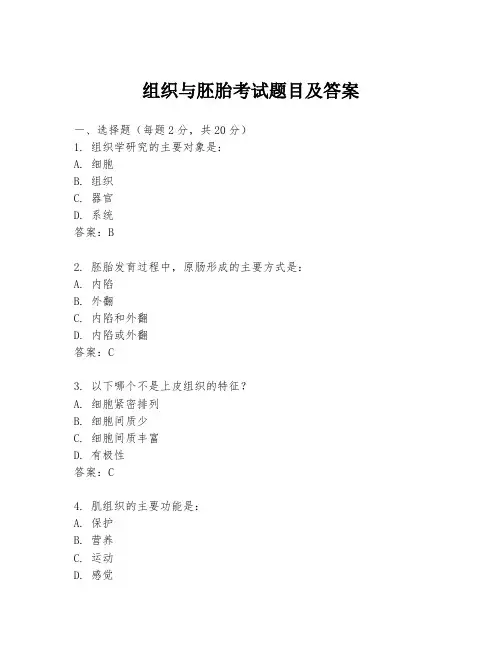
组织与胚胎考试题目及答案一、选择题(每题2分,共20分)1. 组织学研究的主要对象是:A. 细胞B. 组织C. 器官D. 系统答案:B2. 胚胎发育过程中,原肠形成的主要方式是:A. 内陷B. 外翻C. 内陷和外翻D. 内陷或外翻答案:C3. 以下哪个不是上皮组织的特征?A. 细胞紧密排列B. 细胞间质少C. 细胞间质丰富D. 有极性答案:C4. 肌组织的主要功能是:A. 保护B. 营养C. 运动D. 感觉5. 神经组织的基本结构和功能单位是:A. 神经纤维B. 神经元C. 神经胶质细胞D. 神经节答案:B6. 胚胎发育的第三周,心脏开始跳动,此时胚胎被称为:A. 胚泡B. 原肠胚C. 胚胎D. 胎儿答案:C7. 以下哪个不是结缔组织的功能?A. 支持B. 连接C. 保护D. 分泌答案:D8. 胚胎期的神经系统发育始于:A. 第一周B. 第二周C. 第三周D. 第四周答案:C9. 以下哪个器官不是由外胚层发育而来?B. 视网膜C. 肝脏D. 脑答案:C10. 胚胎发育过程中,以下哪个阶段标志着胚胎与母体建立了血液循环联系?A. 胚泡植入B. 原肠形成C. 胚胎期D. 胎儿期答案:A二、填空题(每题2分,共20分)1. 组织学是研究正常人体_______结构和_______的科学。
答案:微细;功能2. 胚胎发育的早期阶段,细胞通过_______和_______形成原肠。
答案:内陷;外翻3. 上皮组织具有_______和_______的特点。
答案:细胞紧密排列;细胞间质少4. 肌组织包括_______、_______和平滑肌三种类型。
答案:骨骼肌;心肌5. 神经组织主要由_______和_______组成。
答案:神经元;神经胶质细胞6. 胚胎发育的第三周,心脏开始跳动,此时胚胎被称为_______。
答案:原肠胚7. 结缔组织的主要功能包括_______、_______和_______。
答案:支持;连接;保护8. 胚胎期的神经系统发育始于_______。
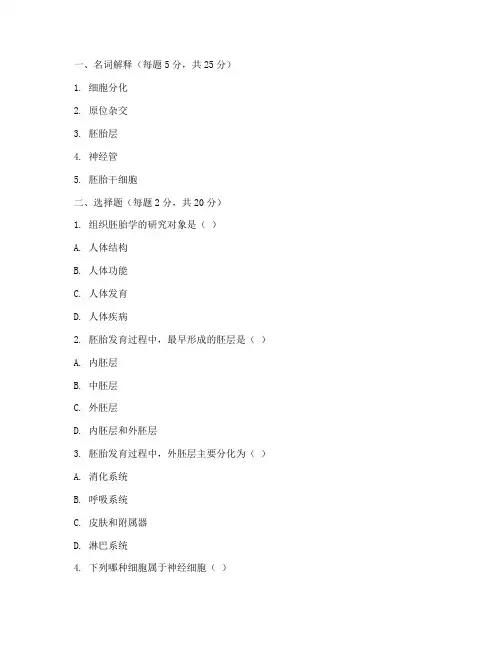
一、名词解释(每题5分,共25分)1. 细胞分化2. 原位杂交3. 胚胎层4. 神经管5. 胚胎干细胞二、选择题(每题2分,共20分)1. 组织胚胎学的研究对象是()A. 人体结构B. 人体功能C. 人体发育D. 人体疾病2. 胚胎发育过程中,最早形成的胚层是()A. 内胚层B. 中胚层C. 外胚层D. 内胚层和外胚层3. 胚胎发育过程中,外胚层主要分化为()A. 消化系统B. 呼吸系统C. 皮肤和附属器D. 淋巴系统4. 下列哪种细胞属于神经细胞()B. 纤维细胞C. 神经胶质细胞D. 脂肪细胞5. 胚胎干细胞的主要来源是()A. 受精卵B. 胚胎囊胚C. 胚胎干细胞系D. 成体干细胞6. 胚胎发育过程中,中胚层主要分化为()A. 皮肤和附属器B. 消化系统C. 呼吸系统D. 淋巴系统7. 下列哪种组织具有再生能力()A. 上皮组织B. 结缔组织C. 神经组织D. 肌组织8. 下列哪种细胞具有吞噬功能()A. 横纹肌细胞B. 纤维细胞C. 神经胶质细胞9. 下列哪种细胞具有分泌功能()A. 横纹肌细胞B. 纤维细胞C. 神经胶质细胞D. 浆细胞10. 下列哪种组织具有营养功能()A. 上皮组织B. 结缔组织C. 神经组织D. 肌组织三、填空题(每题5分,共25分)1. 组织胚胎学是研究__________和__________的学科。
2. 胚胎发育过程中,外胚层主要分化为__________、__________和__________。
3. 中胚层主要分化为__________、__________和__________。
4. 内胚层主要分化为__________、__________和__________。
5. 胚胎干细胞具有__________、__________和__________的特点。
四、简答题(每题10分,共20分)1. 简述胚胎发育过程中的胚层形成过程。
2. 简述上皮组织的结构和功能。
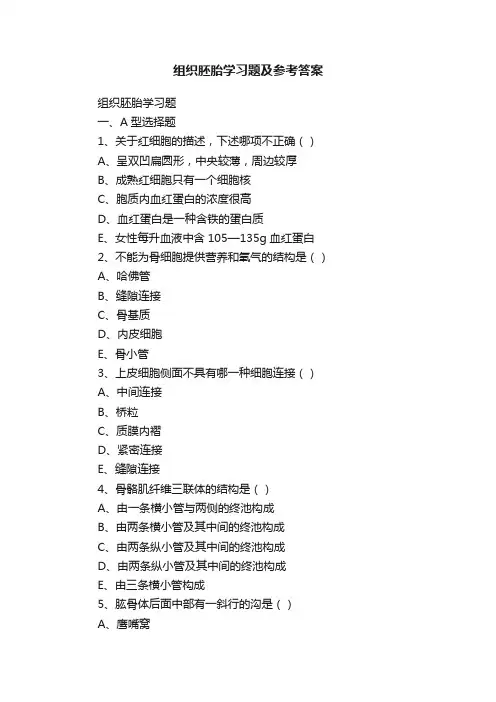
组织胚胎学习题及参考答案组织胚胎学习题一、A型选择题1、关于红细胞的描述,下述哪项不正确()A、呈双凹扁圆形,中央较薄,周边较厚B、成熟红细胞只有一个细胞核C、胞质内血红蛋白的浓度很高D、血红蛋白是一种含铁的蛋白质E、女性每升血液中含105—135g血红蛋白2、不能为骨细胞提供营养和氧气的结构是()A、哈佛管B、缝隙连接C、骨基质D、内皮细胞E、骨小管3、上皮细胞侧面不具有哪一种细胞连接()A、中间连接B、桥粒C、质膜内褶D、紧密连接E、缝隙连接4、骨骼肌纤维三联体的结构是()A、由一条横小管与两侧的终池构成B、由两条横小管及其中间的终池构成C、由两条纵小管及其中间的终池构成D、由两条纵小管及其中间的终池构成E、由三条横小管构成5、肱骨体后面中部有一斜行的沟是()A、鹰嘴窝B、冠突窝C、桡神经沟D、结节间沟E、尺神经沟6、腹股沟管前壁是()A、腹横筋膜B、腹股沟韧带C、腹外斜肌腱膜D、腹直肌前鞘E、腹外斜肌7、上消化道包括()A、口腔、咽腔、食管B、口腔、咽腔、食管、胃、空肠C、口腔、咽腔、食管、胃、十二指肠D、口腔、咽腔、食管、胃、十二指肠和空肠E、口腔、咽腔、食管、胃8、下列关于肾单位的描述中,哪一项错误()A、为肾的结构和功能单位B、由肾小体和肾小管组成C、每个肾所含肾单位多达100万个Ⅰ以上D、肾单位仅位于皮质E、分为皮质肾单位和髓旁肾单位9、心的位置位于()A、胸膜腔内B、胸腔的上纵隔内C、胸腔的中纵隔内D、胸腔的前纵隔内E、胸腔的后纵隔内10、膀胱()A、空虚时膀胱全部位于小骨盆腔内B、男性膀胱后方邻骶骨C、膀胱底的后方有前列腺D、女性膀胱前方邻子宫颈和阴道上段E、秘史于腹膜内位器官11、以下关于子宫内膜的描述中,哪一项错误()A、浅层较厚,称功能层B、功能层为妊娠期胚泡种植和以育的部位C、深层较薄,称臣基底层D、基底层增生能力很强E、功能层和基底层都发生周期性剥脱的出血12、肝基本结构与功能单位是()A、肝板B、肝细胞C、肝血窦D、胆小管E、肝小叶13、关于虹膜的描述,哪一项是错误的()A、为一环形薄膜B、含丰富血管C、含丰富色素细胞D、主要由疏松结缔组织构成E、含丰富感光细胞14、不具有折光作用的结构是()A、晶状体B、玻璃体C、角膜D、睫状体E、瞳孔15、肱骨中部骨折时易损伤()A、正中神经B、腋神经C、桡鹎经D、尺神经E、肌皮神经16、绒毛间隙内含有()A、胎儿的血液B、母体的血液C、母体和胎儿的混合血液D、CO2含量高的血液E、含氧量低的血液17、第二次成熟分裂完成于()A、排卵之前B、排卵时C、排卵后24小时D、排卵后48小时E、受精时18、正常植入部位是()A、子宫颈B、子宫体和底C、腹膜D、输卵管E、以上都不是19、白内障发生在()A、角膜B、玻璃体C、虹膜D、晶状体E、睫状体20、除---外,均为眼球屈光介质()A、房水C、角膜D、晶状体E、玻璃体21、真皮乳头层()A、疏松结缔组织,有环层小体B、致密结缔组织,脂肪较多C、疏松结缔组织,有触觉小体D、致密结缔组织,有环层小体E、疏松结缔组织,脂肪较多22、卵泡生长发育时,子宫内膜为()A、增生期B、分泌期C、排卵期D、月经前期E、月经期23、分泌雄性激素的细胞为()A、间质腺细胞B、膜黄体细胞C、粒黄体细胞D、卵泡细胞E、门细胞24、成人生精小管的上皮为()A、假复层上皮B、复层扁平上皮C、复层柱状上皮D、复层立方上皮E、以上均不对25、精子获得运动能力的场所是()A、输出小管C、输精管D、直精小管E、睾丸网26、致密斑由---分化而来()A、远曲小管上皮B、集合小管上皮C、近曲小管上皮D、远直小管上皮E、近直小管皮27、下列哪项不是肾小管的结构()A、远曲小管 B 、弓形集合小管C、进曲小管D、远直小管E、近直小管28、分泌肺泡表面活性物质的细胞是()A、I形肺泡细胞B、II形肺泡细胞C、III形肺泡细胞D、肺泡巨噬细胞E、刷细胞29、气管壁的上皮是()A、单层柱状上皮B、假复层柱状纤毛上皮C、单层立方上皮D、复层柱状上皮E、复层柱状纤毛上皮30、肝细胞分泌胆汁最先进入()A、肝血窦B、胆小管C、小叶间胆管D、中央静脉E、Disse隙二、填空题1、结缔组织分为、、、四种类型。
组织胚胎学试题库(附参考答案)一、单选题(共70题,每题1分,共70分)1、HE染色切片中近端小管曲部的细胞界限不清,其主要原因是A、细胞膜极薄B、相邻细胞侧突互相嵌合C、细胞质嗜色性太弱D、细胞间质极少E、细胞膜易于溶解正确答案:B2、关于食管腺,正确的是A、位于固有层B、分泌淀粉酶C、位于黏膜下层D、位于内环外纵肌纤维E、为纯浆液性腺正确答案:C3、可发生周期性脱落的子宫内膜称为A、功能层B、基底层C、分泌期D、月经期E、增生期正确答案:A4、关于滤过膜的结构特征,哪项错误A、内皮与足细胞间有一层完整的基膜B、足细胞裂孔上无隔膜有利于滤过C、足细胞突起包绕毛细血管,突起间有裂孔D、内皮腔面有一层带负电荷的糖蛋白E、血管球毛细血管内皮有许多小孔正确答案:B5、白细胞分类的主要依据是A、胞质有无特殊颗粒及颗粒的嗜色性B、细胞核有无分叶C、胞质的嗜色性D、胞质的嗜色性和核的形态E、核的形态正确答案:A6、关于脾的功能特征,错误的是A、脾索有滤血功能B、制造抗体及产生效应淋巴细胞C、对血源性抗原物质产生免疫应答D、无造血干细胞,故无造血潜能E、脾血窦有储血功能正确答案:D7、有关胰腺腺泡的描述,错误的是?A、是混合性腺泡B、外有基膜C、无肌上皮细胞D、有泡心细胞E、与闰管相连正确答案:A8、卵巢排卵时,子宫内膜处于A、分泌晚期B、增生末期C、分泌早期D、月经期E、增生早期正确答案:B9、内皮特征性结构是A、丰富的紧密连接B、丰富的溶酶体C、W-P小体D、细胞间有10-20nm的间隙E、发达的高尔基复合体正确答案:C10、关于淋巴结的错误描述是A、实质可分为皮质和髓质两部分B、皮质由浅层皮质、副皮质区及皮质淋巴窦构成C、浅层皮质和副皮质区为B细胞区D、皮质淋巴窦包括被膜下窦和小梁周窦E、髓索内含的浆细胞在此分泌抗体正确答案:C11、关于支气管树结构的变化错误的是A、肌层越来越薄B、上皮逐渐变薄,杯状细胞逐渐变少以至消失C、软骨呈不规则片状,逐渐减少以至消失D、管径逐渐变细,管壁逐渐变薄E、腺体逐渐变少,最后消失正确答案:A12、关于终末细支气管,哪项错误?A、上皮为单层柱状B、有完整的环行平滑肌C、有少量杯状细胞和腺体D、上皮中有Clara细胞E、黏膜皱襞明显正确答案:C13、有关中央乳糜管,正确是?A、是一种闰管B、位于脾白髓C、是一种毛细淋巴管D、位于微绒毛中轴E、是一种毛细血管正确答案:C14、远侧部腺细胞的分泌功能受下列哪种激素的调节A、下丘脑视上核分泌的激素B、下丘脑弓状核分泌的激素C、正中隆起分泌的激素D、下丘脑室旁核分泌的激素E、神经部分泌的激素正确答案:B15、构成粗肌丝的蛋白质是A、肌红蛋白B、肌钙蛋白C、原肌球蛋白D、肌动蛋白E、肌球蛋白正确答案:E16、肺泡隔的主要成份是A、毛细血管、网状纤维和成纤维细胞B、毛细血管、胶原纤维和巨噬细胞C、弹性纤维、胶原纤维和成纤维细胞D、毛细血管、弹性纤维和巨噬细胞E、弹性纤维、网状纤维和成纤维细胞正确答案:D17、脐带形成后,包在脐带外面的是A、羊膜B、绒毛膜C、卵黄囊D、外胚层E、胚外中胚层正确答案:A18、关于中动脉的描述,错误的是A、外弹性膜明显B、有调节各器官血流量的作用C、中膜大量环形平滑肌D、又称肌性动脉E、内弹性膜不明显正确答案:E19、分泌抑制素的细胞是A、支持细胞B、初级精母细胞C、精原细胞D、附睾上皮细胞E、睾丸间质细胞正确答案:A20、下列关于体节的分化和演变的描述,错误的是A、体节分化为泌尿系统B、生肌节演变为躯干和四肢的骨骼肌C、分化为生皮节、生肌节和生骨节D、生皮节演变为骨干和四肢的真皮E、生骨节演变为中轴骨骼正确答案:A21、溶血性链球菌和肿瘤细胞等可产生哪种物质破坏基质的防御屏障A、溶菌酶B、碱性磷酸酶C、透明质酸酶D、酸性磷酸酶E、胶原蛋白酶正确答案:C22、关于心瓣膜的描述,错误的是?A、患风湿性心脏病时,瓣膜病变而不能正常管壁B、能防止心房和心室收缩时血液倒流C、表面衬一层内皮细胞,中心为致密结缔组织D、位于房室口和动脉口处E、是心内膜和心肌膜共同形成正确答案:E23、输卵管壁的组成为A、上皮、固有层、黏膜肌层B、黏膜、肌层、浆膜C、黏膜、肌层、纤维膜D、黏膜、黏膜下层、肌层和浆膜E、上皮、肌层、浆膜正确答案:B24、有关脾的结构,哪项错误A、脾血窦由长杆状内皮细胞组成B、含有大量血窦,无淋巴窦C、实质由皮质和髓质构成D、被膜表面覆有间皮E、脾血窦内皮细胞外有不完整的基膜正确答案:C25、关于大肠的结构特征,哪一项错误?A、杯状细胞含量多B、固有层内有较多的孤立淋巴小结C、黏膜无绒毛D、柱状上皮细胞表面有纹状缘E、肠腺长而密正确答案:D26、肺内分泌表面活性物质的细胞是A、小颗粒细胞B、肺泡巨噬细胞C、I型肺泡细胞D、杯状细胞E、II型肺泡细胞正确答案:E27、正常妇女一生总共排出多大卵子A、1500个B、1000个C、200个D、800个E、400个正确答案:E28、精子的顶体是特殊的A、滑面内质网B、中心粒C、线粒体D、粗面内质网E、溶酶体正确答案:E29、相邻骨细胞突起之间有A、连接复合体B、中间连接C、缝隙连接D、紧密连接E、桥粒正确答案:C30、月经期后修复子宫内膜上皮的是A、螺旋动脉内皮细胞B、基质细胞C、基底层子宫腺上皮细胞D、以上都对E、以上都不对正确答案:C31、子宫内膜处于分泌期时,卵巢内A、卵泡生长B、卵泡成熟C、黄体退化D、黄体生长E、即将排卵正确答案:D32、又名黄纤维的是A、胶原纤维B、胶原原纤维C、网状纤维D、微原纤维E、弹性纤维正确答案:E33、对于浆细胞的描述,哪一项是错误的?A、细胞呈圆形或椭圆形B、细胞质呈强嗜碱性,近细胞核处是一着色较浅透明区C、细胞核圆形,常偏于细胞一侧,核内染色质丰富,成辐射状排列D、电镜下可见胞质内含大量的滑面内质网和发达的高尔基体E、可产生抗体,参与机体的体液免疫正确答案:D34、关于肾上腺皮质的描述,错误的是A、分为球状带、束状带、网状带B、网状带分泌性激素C、球状带分泌盐皮质激素D、细胞属于分泌含氮激素细胞E、束状带分泌糖皮质激素正确答案:D35、关于肝小叶的描述,错误的是?A、中央静脉的管壁无平滑肌B、肝板通过分支互连呈网C、胆小管在肝板内互连呈网D、肝血窦互连成网E、胆小管与窦周隙连通正确答案:E36、网织红细胞中用煌焦油蓝染色,被染成蓝色的不规则颗粒或细网状结构是A、破碎的细胞核B、线粒体C、滑面内质网D、高尔基复合体E、核糖体正确答案:E37、弹性软骨与透明软骨结构的主要区别是A、基质成分不同B、软骨细胞不同C、纤维类型不同D、分布部位不同E、纤维数量和排列不同正确答案:C38、下列精子染色体的组合中,哪种与卵细胞结合后发育成为男性胚胎A、21条常染色体,加1条Y染色体和l条X染色体B、23条常染色体,加1条Y染色体C、23条常染色体,加1条X染色体D、22条常染色体,加l条X染色体E、22条常染色体,加1条Y染色体正确答案:E39、骨骼肌纤维的肌膜向胞质内凹陷形成A、纵小管B、三联体D、横小管E、肌浆网正确答案:D40、关于小肠绒毛的描述,正确的是?A、上皮、固有层向肠腔突出而成B、黏膜和黏膜下层向肠腔突出而成C、上皮、固有层、黏膜肌层向肠腔突出而成D、柱状上皮游离面向肠腔突出而成E、小肠各段的绒毛均一致正确答案:A41、关于血管球的结构特征,哪项错误A、参与构成滤过屏障B、由入球微动脉分支而形成C、被肾小囊包裹D、为窦状毛细血管E、内皮腔面被覆有糖蛋白正确答案:D42、窦周隙存在于?A、相邻肝细胞之间B、肝血窦内皮之间C、肝细胞和胆小管之间D、肝血窦内皮细胞之间与肝巨噬细胞之间E、肝细胞与肝血窦内皮之间正确答案:E43、骨骼肌纤维内储存钙离子的结构主要是A、肌浆B、线粒体C、横小管D、粗面内质网E、肌浆网正确答案:E44、神经元传导神经冲动是通过A、微管C、神经内膜D、突触小泡E、神经束膜正确答案:B45、电镜下尼氏体的结构是A、粗面内质网和溶酶体B、粗面内质网和高尔基复合体C、粗面内质网和游离核糖体D、滑面内质网和游离核糖体E、神经丝和微管正确答案:C46、属于单核吞噬细胞系统的细胞是A、施万细胞B、卫星细胞C、少突胶质细胞D、小胶质细胞E、星形胶质细胞正确答案:D47、关于胰岛的描述,错误的是?A、腺泡之间的内分泌细胞团B、细胞间有丰富的毛细血管C、大小不等D、胰尾部较多E、胰头部较多正确答案:E48、毛细血管的构成包括A、内皮、基膜、周细胞和平滑肌B、内皮和基膜C、内膜、中膜、外膜D、内皮、基膜和周细胞E、内皮、基膜、平滑肌正确答案:D49、关于脾和淋巴结的共同点,哪项错误A、实质均由皮质和髓质构成B、被膜组织均伸入实质构成小梁C、均有胸腺依赖区D、均有淋巴小结E、均能参与细胞免疫和体液免疫正确答案:A50、肝细胞内,与胆汁合成和分泌有关的细胞器是?A、溶酶体,微体B、滑面内质网,高尔基复合体C、粗面内质网,溶酶体D、粗面内质网,高尔基复合体E、滑面内质网,微体正确答案:B51、产生肝素的细胞是A、巨噬细胞B、浆细胞C、脂肪细胞D、成纤维细胞E、肥大细胞正确答案:E52、关于致密斑的描述,哪项正确A、由远端小管近血管极处的上皮细胞形成B、由近端小管近血管极处的上皮细胞形成C、能感受滤液中Na+的变化,分泌肾素D、细胞排列紧密,呈立方形E、由入球微动脉近血管极处的内皮细胞形成正确答案:A53、血小板的寿命是A、2~3天B、7~14天C、120天D、10~15天E、8~10天正确答案:B54、关于Ⅰ型肺泡细胞,哪项错误?A、胞质内含吞饮小泡B、可分裂增殖,修复肺泡C、是一种扁平的细胞D、是气体交换的部位E、表面有一层表面活性物质正确答案:B55、肺的实质是指A、肺内支气管各级分支、大量肺泡和血管B、肺内支气管各级分支、大量肺泡和血管、淋巴管、神经等C、肺内支气管各级分支和大量肺泡D、肺内支气管各级分支、大量肺泡和淋巴管E、大量的肺泡正确答案:C56、肌细胞的滑面内质网特称A、肌浆网B、纵小管C、终池D、密体E、横小管正确答案:A57、肺导气部包括A、叶支气管、段支气管、小支气管、细支气管B、叶支气管、段支气管C、小支气管、细支气管、段支气管D、叶支气管、段支气管、小支气管、细支气管、终末细支气管E、叶支气管、段支气管、小支气管、细支气管、终末细支气管、呼吸细支气管正确答案:D58、脾脏内属于胸腺依赖区的是:A、边缘区B、脾索C、淋巴小结D、脾血窦正确答案:A59、数量最多的神经元是A、高尔基I型神经元B、中间神经元C、运动神经元D、感觉神经元E、高尔基Ⅱ型神经元正确答案:B60、关于基膜的描述,哪项错误?A、具有连接、支持和半透膜的作用B、基板由上皮细胞分泌产生C、是位于上皮和结缔组织之间的薄膜D、电镜下由网板和基板构成E、光镜下,基膜都清晰可见正确答案:E61、外膜厚,外膜中含大量纵行平滑肌束的是A、小动脉B、中动脉C、中静脉D、大静脉E、大动脉正确答案:D62、青春期前,生精小管上皮中一般只有A、精原细胞和精子B、精原细胞和初级精母细胞C、精原细胞和支持细胞D、精子细胞和精子E、初级精母细胞和支持细胞正确答案:C63、关于胰腺泡心细胞的描述,正确的是?A、是黏液性腺细胞B、脱落的腺细胞C、是血管内皮细胞D、属于闰管的上皮细胞E、是浆液性腺细胞正确答案:D64、小肠潘氏细胞内的嗜酸性分泌颗粒内含有?A、蛋白酶B、溶菌酶C、过氧化物酶D、脂酶E、组织胺酶正确答案:B65、人体胚胎早期发生时期是从受精至A、第1周B、第3周C、第4周D、第8周E、第6周正确答案:D66、不属于垂体前叶的结构有A、嫌色细胞B、嗜酸性细胞和嗜碱性细胞C、赫令体D、丰富的血窦E、少量结缔组织正确答案:C67、心肌纤维的闰盘位于A、Z线水平B、I带水平C、A带与I带交界处D、A带水平E、M线水平正确答案:E68、关于脾淋巴小结,错误的是A、位于动脉周围淋巴鞘一侧B、主要由T淋巴细胞构成C、有小结帽、明区和暗区之分D、参与体液免疫E、主要由大量B细胞构成正确答案:B69、和男性第二性征直接有关的激素是A、醛固酮B、黄体生成素C、雄激素D、卵泡刺激素E、糖皮质激素正确答案:C70、关于微绒毛叙述,哪项错误A、光镜下清晰可见B、可扩大细胞的表面积C、上皮细胞游离面所特有D、可伸长或缩短E、含有许多纵行微丝正确答案:A二、多选题(共20题,每题1分,共20分)1、关于内分泌腺,哪项正确?A、无导管B、毛细血管丰富C、其分泌物为激素D、腺细胞排列成索状、团状或滤泡状E、有导管正确答案:ABCD2、嗜碱性粒细胞的嗜碱性颗粒中含A、组胺B、肝素C、组胺酶D、过氧化物酶E、嗜酸粒细胞趋化因子正确答案:ABE3、T细胞的特点是A、在骨髓内受抗原的刺激而增殖分化B、外周血中的T细胞少于B细胞C、在淋巴结内,主要分布于副皮质区D、在脾内,主要分布于动脉周围淋巴鞘E、与细胞免疫应答有关正确答案:CDE4、有关化学突触正确的是A、突触前膜上有钙离子通道B、突触后膜上有受体C、突触间隙为突触前、后膜之间相对的狭小间隙D、突触前成分内有突触小泡E、突触的结构包括突触前膜、突触后膜两部分正确答案:ABCD5、胎盘分泌的激素有A、催产素B、孕激素C、雌激素D、人胎盘催乳素E、绒毛膜促性腺激素正确答案:BCDE6、参与调节血钙浓度的是?A、垂体嗜碱性细胞B、甲状腺主细胞C、甲状旁腺主细胞D、甲状腺滤泡旁细胞E、甲状旁腺滤泡旁细胞正确答案:CD7、终末细支气管的特点是:A、单层柱状上皮B、杯状细胞、腺体、软骨全部消失C、有完整的环行平滑肌D、黏膜皱襞明显E、假复层纤毛柱状上皮正确答案:ABCD8、黏膜上皮不含杯状细胞的器官是A、食管B、阑尾C、胃D、空肠E、结肠正确答案:AC9、关于纤毛的特点,下列叙述正确的是A、内有纵向配布的微管B、为一种特殊的细胞器C、分布在呼吸道D、可按一定的节律摆动E、光镜下可见正确答案:ACDE10、气-血屏障包括A、Ⅰ型肺泡细胞及基膜B、肺泡表面活性物质层C、毛细血管基膜和内皮D、薄层结缔组织E、Ⅱ型肺泡细胞及基膜正确答案:ABCD11、下列哪些是巨噬细胞的功能A、分泌抗体B、分泌溶菌酶C、抗原呈递D、分泌组胺和肝素E、吞噬功能正确答案:BCE12、盐酸的作用是A、杀菌B、稀释毒物C、消化蛋白质D、激活胃蛋白酶原E、促进维生素B12吸收正确答案:AD13、关于Ⅰ型肺泡细胞的描述,正确的是:A、能分泌肺泡表面活性物质B、参与组成气-血屏障C、基底面有基膜D、能胞吞表面活性物质E、能增殖、自我更新正确答案:BCD14、组成长骨骨干密质骨的骨板有A、骺板B、外环骨板C、间骨板D、内环骨板E、哈弗斯系统正确答案:BCDE15、关于门管区的描述正确的是A、有结缔组织B、有小叶间动脉、小叶间静脉、小叶间胆管C、有小叶间动脉、小叶下静脉、小叶间胆管D、位于相邻肝小叶之间E、小叶间胆管为单层柱状上皮正确答案:ABD16、下列关于浅表肾单位的描述,正确的是A、髓袢较短B、数量多C、分布在肾柱D、体积较大E、是重要的尿液形成单位正确答案:ABE17、固有结缔组织中除疏松结缔组织外还包括A、致密结缔组织B、软骨组织C、脂肪组织D、组织液E、网状组织18、肝细胞的邻接面有A、血窦面B、胆小管面C、肝细胞连接面D、肝板面E、以上都不对正确答案:ABC19、关于哈弗斯系统的叙述正确的是A、是长骨中起支持作用的主要结构B、中央管内有血管、神经和少量结缔组织C、平行于长骨长轴D、由同心圆排列的骨板围成E、哈弗斯系统粗细一致正确答案:ABCD20、甲状腺滤泡旁细胞A、分泌甲状腺素B、分泌降钙素C、在HE染色切片中胞质浅染D、位于滤泡之间和滤泡上皮细胞之间E、分泌甲状旁腺素正确答案:BCD三、判断题(共10题,每题1分,共10分)1、排卵一般发生在月经周期的第5-10天。
组织胚胎学题库含答案一、单选题(共100题,每题1分,共100分)1、关于胰岛的描述哪项错误( )A、大小不等B、胰尾中胰岛最多C、胰头部最多D、胰岛是腺泡之间的细胞团E、胰头和胰体较少正确答案:C2、下列哪种纤维可称为嗜银纤维( )A、胶原纤维B、神经原纤维C、胶原原纤维D、弹性纤维E、网状纤维正确答案:E3、胃底腺壁细胞的特点是 ( )A、细胞内微管泡系统是细胞内分泌小管的储备形式B、以上选项全对C、有丰富的线粒体D、细胞内分泌小管与盐酸的形成有关E、细胞呈圆锥形,胞质强嗜酸性正确答案:D4、下列纤维,何种纤维是细胞间质( )A、神经原纤维B、肌纤维C、神经纤维D、胶原纤维E、肌原纤维正确答案:D5、内皮细胞的特性结构是( )A、丰富的溶酶体B、细胞间有10--20nm的间隙C、丰富的紧密连接D、发达的高尔基复合体E、W-P小体正确答案:E6、关于被覆上皮的特点哪项错误( )A、细胞间质少B、无神经和血管C、基底面都有基膜D、细胞排列紧密E、细胞呈极性分布正确答案:B7、中动脉中膜的主要成分是( )A、平滑肌纤维B、弹性纤维C、胶原纤维D、神经纤维E、网状纤维正确答案:A8、真皮乳头层的特点之一是( )A、纤维成分细,毛细血管少B、纤维成分粗,毛细血管丰富C、纤维成分细,毛细血管丰富D、纤维成分粗,毛细血管少正确答案:C9、生长卵泡包括( )A、次级卵泡和三级卵泡B、初级卵泡、次级卵泡和三级卵泡C、初级卵泡和成熟卵泡D、原始卵泡和初级卵泡正确答案:B10、大脑皮质的梭形细胞位于( )A、内颗粒层B、外颗粒层C、内锥体细胞层D、外锥体细胞层E、多形细胞层正确答案:E11、平滑肌纤维的中间丝起( )A、保护作用B、骨架作用C、收缩作用D、连接作用E、滑动作用正确答案:B12、关于单核细胞的描述哪项错误( )A、嗜天青颗粒含过氧化物酶B、是组织中巨噬细胞的前身C、起源于淋巴器官D、血液中体积最大的细胞正确答案:C13、神经元传导冲动是通过( )传导。
组织胚胎学复习题与答案一、选择题1. 以下哪项不属于胚胎发育的三个阶段?A. 胚胎前期B. 胚胎期C. 胚胎后期D. 胎儿期答案:C2. 以下哪种细胞不属于胚胎干细胞?A. 胚胎干细胞B. 胚胎癌细胞C. 成纤维细胞D. 胚胎神经干细胞答案:C3. 以下哪个过程不属于胚胎发育过程中的细胞分化?A. 细胞增殖B. 细胞迁移C. 细胞凋亡D. 细胞黏附答案:A4. 以下哪个器官不在胚胎发育过程中形成?A. 心脏B. 脑C. 肺D. 肝答案:D5. 以下哪个结构不属于胚胎发育过程中的胚层?A. 内胚层B. 中胚层C. 外胚层D. 神经胚层答案:D二、填空题1. 胚胎发育过程中,胚胎干细胞主要来源于__________。
答案:囊胚期的内细胞团2. 胚胎发育过程中,细胞分化主要发生在__________阶段。
答案:胚胎期3. 胚胎发育过程中,胚层形成的主要过程是__________。
答案:细胞增殖和分化4. 胚胎发育过程中,心脏发育的关键时期是__________。
答案:胚胎第4周5. 胚胎发育过程中,神经系统的发育主要发生在__________阶段。
答案:胚胎期三、判断题1. 胚胎发育过程中,细胞分化是不可逆的。
()答案:正确2. 胚胎发育过程中,细胞凋亡是正常现象,对胚胎发育有促进作用。
()答案:正确3. 胚胎发育过程中,内胚层主要分化为消化系统、呼吸系统等器官。
()答案:正确4. 胚胎发育过程中,中胚层主要分化为骨骼、肌肉、心血管系统等器官。
()答案:正确5. 胚胎发育过程中,外胚层主要分化为神经系统、皮肤等器官。
()答案:正确四、简答题1. 简述胚胎发育过程中细胞分化的特点。
答案:胚胎发育过程中细胞分化的特点有:(1)不可逆性:一旦细胞分化,就不能再回到未分化状态;(2)多样性:细胞分化形成多种类型的细胞,具有不同的结构和功能;(3)有序性:细胞分化按照一定的时间和空间顺序进行;(4)遗传性:细胞分化受到遗传信息的调控。
第一章绪论(2学时)一. Single Choice1. Which of the following are not the main research contents?2. About embryology, which of the following answer is wrong?A. Dealing with the development and maturation of gamets.B. Dealing with how the gamets develop and become mature.C. Usually regarded as the period starting with fertilization and ending with birth in mammals.D. Usually ended with birth in mammals.3. Which of the following constitute the development history of histology EXCEPTA. Invention of light microscope.B. Invention of electron microscope.C. Contemporary histology.4. Why do the medical students study the subject of animal histology and embryology EXCEPTA. To complete the knowledge of body’s structures-from gross to microscopic.B. Be able to understand how the different tissue’s function-the basis of physiology.C. Can find the disease only after the normal structure is known-the basis of pathology.D. It is a foundation of clinic sciences- for a good veterinary doctor needed in future.5. About the light microscopy, which of the following is false?A. Light microscopy includes two main parts: common light microscopy and special light microscope.B. Optical part of the common light microscopy includes condenser, objective and eyepiece.C. Mechanical part of the common light microscopy includes stage, focus adjustment knob, stage position adjustment.D. The common light microscope can be adapted to observe paraffin section with hematoxyin and eosin (H-E).and eosin (H-E).6. Which of the following is not related to paraffin section?A. Specimen-collecting and fixationB. Dehydration and clearing.C. Paraffin-infiltrating and embedding.D. Sectioning and staining.7. Hematoxyin and eosin (H-E) staining includes all of the following EXCEPT8. Which of the following is not included in the special light microscope?.A. Fluorescence microscope;ser confocal scanning microscopy;9. About the comparison of the transmission electron midcroscope (TEM) and light microscope(LM), which is not true?A. They are completely different in section preparation.B. TEM using a beam of electrons.C. Resolution of TEM is 0.1-0.5nm.D. TEM using heavy metal salts to stain instead of H.E.二.名词解释:Histology(组织学); embryology(胚胎学).三.问答题:1.什么叫动物组织学,动物胚胎学?其研究内容是什么?2.组织片的常规染色法是哪一种?什么叫PAS反应?3.解释嗜酸性、嗜碱性、中性。
组织学与胚胎学考试必备第一章组织学绪论选择题:一、A型题1. 电子显微镜最高的分辨率为:A 0.2nmB 2nm Cμm D 10nm Eμm2. 光学显微镜最高的分辨率为:A 2nm Bμm C 0.2nm D 2μm E 5μm第二章上皮细胞一、A型题1.关于上皮细胞的功能哪项错误?A分泌 B 呼吸 C 保护 D 营养 E 排泄2.未角化复层鳞状上皮细胞分布在下列哪个器官?A食管B气管C输卵管D输精管E输尿管3.关于被覆上皮的特点下列哪项是错误?A被覆在身体表面和器官腔面B上皮内有丰富的血管C具有高度的再生能力D细胞形状较规则并排列紧密E有内胚层` 中胚层和外胚层发生4.下列哪个器官被覆单层柱状上皮?A血管B膀胱C皮肤D小肠E食管5.关于复层扁平上皮的哪项特点是正确的?A细胞层数多,是最厚的一种上皮B浅层为柱状细胞C细胞间隙宽,其中有毛细血管D上皮与结缔组织的连接面平直E被覆在小肠腔面6.下列关于变移上皮的特点哪项是错误的?A分布于排尿管道的大部分B细胞的层次与形状可随器官胀缩而改变C表层细胞呈大立方形,可有二个细胞核D有分泌作用E表层细胞有防止尿液侵蚀的作用7.下列哪种结构不属于细胞间连接?A桥粒B中间连接C缝隙连接D紧密连接E半桥粒8.下列关于纤毛的描述哪项是错误的?A纤毛表面有细胞膜,内为细胞质,含有纵行的微管B微管的排列,外周为九组双联微管,中央为二条单微管C微管的下端与基体相连D纤毛的摆动是由于微管的相互滑动E参与细胞的吸收作用9.关于假复层纤毛柱状上皮的特点哪项错误?A细胞的表面均有纤毛B所有的细胞都附在基膜上C属于单层上皮D细胞高矮不同,故细胞核不在同一个平面E具有分泌和保护作用10.光镜下所见的纹状缘或刷状缘,电镜下是:11.A微管B微丝C纤毛D微绒毛E张力丝12.关于基膜描述哪项是错误?A基膜是物质通透的半透膜B基膜由基板和网板组成C基板和网板均由上皮细胞产生D基板又可分为透明层和致密层,网板有网状纤维和基质构成E基板的成分主要是Ⅳ型胶原蛋白和层粘连蛋白13.关于基膜内褶哪项错误?A这种结构能加强上皮和基膜间的连接B扩大细胞表面积,加强水和电解质转运C多分布于肾的近端D是上皮细胞基底面的细胞膜向胞质内褶叠形成E在内褶处有许多纵行线粒体第三章结缔组织一、A型题1.关于疏松结缔组织的描述,哪项错误?A细胞外基质少B细胞分散在细胞外基质中C细胞外基质由纤维、基质和组织液组成D存在的细胞类型较多E由胚胎期的间充质发生2.下列哪项的细胞不能产生胶原蛋白?A成纤维细胞B成骨细胞C软骨细胞D某些平滑肌细胞和上皮细胞E神经胶质细胞3.关于巨噬细胞,哪项是错误?A胞核较小、呈圆形或椭圆形,着色较深B胞质丰富,呈嗜酸性C胞质含许多溶酶体,吞噬小泡和吞噬体D有活跃的变形运动和吞噬作用E产生基质和纤维4.关于浆细胞的特点哪项是错误的?A受抗原刺激后,由T淋巴细胞分化B细胞核呈嗜碱性,胞核附近有浅染区C胞核偏居细胞一侧,染色质呈辐射状D有发达的高尔基复合体E合成和分泌免疫球蛋白5.浆细胞胞质呈嗜碱性是由于:A有丰富的粗面内质网B高尔基复合体发达C线粒体丰富D滑面内质网丰富E溶酶体丰富6.关于肥大细胞的特点哪项是错误的?A细胞呈圆形或卵圆形B胞核较小,为圆形C胞质内充满粗大的异染性颗粒D颗粒易溶于水E有活跃的吞噬能力7.结缔组织中能产生肝素的细胞是:A成纤维细胞B浆细胞C肥大细胞D巨噬细胞E间充质细胞8.巨噬细胞是由下列哪种细胞分化的:A间充质细胞B网状细胞C单核细胞D巨核细胞E中性粒细胞9.关于胶原纤维下列哪项是错误的:A有韧性抗拉力强B新鲜时呈黄色,也称黄纤维C由胶原原纤维聚合而成D呈波浪状,有分支交织成网E HE染色呈嗜酸性10.电镜下能看出周期性横纹的结构是:A神经原纤维B神经纤维C弹性纤维D胶原原纤维E平滑肌纤维11.下列哪种细胞与免疫无关?A成纤维细胞B浆细胞C肥大细胞D巨噬细胞E嗜酸性粒细胞12.关于弹性纤维的特点哪项是错误的:A由弹性蛋白和微原纤维组成B电镜下具有明暗相间的周期性横纹C HE染色标本上呈浅红色,折光性强D弹性大,韧性差E新鲜时呈黄色13.关于间充质细胞的描述哪项是错误:A可分化为平滑肌细胞B胚胎时期可分化为各种结缔组织细胞C成体可分化为内皮细胞D能产生纤维和基质E形态与成纤维细胞相似14.下列成分中具有防御保护功能是:A基质B组织液C胶原纤维D弹性纤维E网状纤维15.疏松结缔组织基质的化学成分是:A蛋白多糖和糖蛋白B透明质酸C蛋白质D肝素E硫酸软骨素16.光镜下所见的纹状缘或刷状缘,电镜下是:A微管B微丝C纤毛D微绒毛E张力丝第四章软骨与骨一、A型题1.类骨质是指哪种物质:A未钙化的细胞外基质B钙化的细胞外基质C钙化的基质和纤维D骨盐E未形成骨板的骨基质2.下列哪种成分不是骨组织的组成成分:A胶原蛋白B蛋白多糖C羟基磷灰石D骨细胞E弹性纤维3.关于成骨细胞的特点哪项是错误的:A细胞呈柱状或椭圆形分布在骨质的表面B胞质显嗜碱性C粗面内质网丰富D有丰富的碱性磷酸酶E高尔基复合体发达4.关于破骨细胞哪项是错误的:A是含一个胞核的大细胞B甲状旁腺激素可抑制其破骨功能C释放多种蛋白酶使局部骨质溶解D由多个单核细胞融合形成E临近骨质的一侧有皱褶缘5.关于骨小管哪项是错误的:A使骨单位中的骨陷窝相互通连B容纳骨细胞的突起C使骨单位最内层的骨陷窝与中央管通连D含有毛细血管E含有组织液6.骨细胞突起之间以何种方式连接:A中间连接B紧密连接C缝隙连接D桥粒E彼此不行成连接7.HE标本中不能分辨透明软骨纤维是由于:A基质中不含纤维B纤维为嗜银性C纤维少D纤维的嗜色性与基质相同E因含有胶原原纤维,折光率与基质相同8.关于软骨细胞的形态结构哪项错误:A细胞呈扁圆或球形B胞质内丰富粗面内质网和高尔基复合体C有丰富的溶酶体D胞质呈弱嗜碱性E细胞产生纤维和基质9.关于骨基质哪项错误:A由有机成分和无机成分组成B骨板是骨基质的结构形成C骨基质即骨的细胞外基质D有机成分为糖胺多糖E无机成分为羟磷石结晶10.关于骨板哪项错误:A骨板是由有机成分排列成的薄板状结构B骨板是骨基质形成的薄板状结构C同一层骨板中胶原纤维平行排列D骨密质和骨松质都有骨板E骨板内和骨板间有骨细胞11.破骨细胞的特点是:A能溶解吸收骨质B能进行分裂C从骨原细胞分裂而来D胞质内可见吸收的骨质E降钙素能增强其活动12.关于骨单位的特点哪项错误:A骨单位顺骨干长轴纵向排列B骨单位之间有分支相连C骨单位中央管内无血管神经D骨单位中央管内表面衬有骨内膜E多层骨板围绕中央管呈同心圆排列13.关于骨膜的描述哪项错误:A骨膜为致密结缔组织,分为内、外两层B骨膜外层纤维多,细胞和血管少C骨膜内层细胞多,血管多,有骨原细胞D骨膜内层骨原细胞分化形成成骨细胞E骨小梁和骨单位中央管内无骨膜14.关于股和软骨的共同特征哪项错误:A细胞外基质有基质和纤维B都以内积生长形式生长C细胞都为于陷窝内D软骨膜和骨膜都有骨原细胞E骨细胞和软骨细胞都来源于骨原细胞15.关于骨细胞的描述哪项是错误:A有突起,但不位于骨小管B骨小管内含有组织液C胞浆内无微管D相邻骨细胞突起间以桥粒相连E以上均正确第五章血液一、A型题1.关于红细胞哪项是错误的?A成熟的红细胞已失去了细胞核B胞质中充满血红蛋白C细胞呈双凹的圆盘状D细胞的平均寿命为120dE向全身的组织和细胞供给氧气,带走含氮的代谢产物2.关于嗜酸性粒细胞哪项是正确的?A胞质的特殊颗粒含有组胺B再发生急性炎症疾病时显著增多C由多核细胞发生D细胞核分4~5叶E在过敏性疾病和寄生虫病时增多3.关于中性粒细胞哪项是错误的?A占白细胞总数的50%~70% B细胞核呈杆状或分叶状C胞质中含嗜天青颗粒和特殊颗粒D在急性炎症疾病时明显增多E胞质的特殊颗粒含组胺、肝素和白三烯4.关于嗜碱性粒细胞哪项是正确的?A占白细胞总数的3%~8% B细胞质具有强嗜碱性C胞核呈圆形D胞质中含嗜碱性特殊颗粒E在急性细菌性感染疾病时明显增多5.在发生红细胞最早的部位是:A卵黄囊血岛B骨髓C肝D淋巴结E脾6.关于血小管哪项是正确的?A是有核的细胞B细胞直径为7~8μm C胞质中含有嗜碱性的特殊颗粒D胞质的特殊颗粒含组胺和肝素E在止血和凝血过程中起重要作用7.关于单核细胞哪项错误?A占白细胞总数的3%~8% B是体积最大的白细胞C细胞核呈椭圆形或肾形,着色较浅D胞质中含溶酶体和吞噬泡E胞质分隔成许多小区,脱落后形成血小板8.网织红细胞中的血红蛋白在下列哪种结构内合成?A滑面内质网B多聚核糖体C溶酶体D线粒体E高尔基复合体9.关于网织红细胞哪项错误?A未完全成熟的红细胞B胞质内有用煌焦油蓝染色的蓝色细网C数量变化具有临床意义D无合成血红蛋白能力E胞质有残存的核糖体10.关于嗜碱性粒细胞哪项错误?A核呈S型或不规则形B是数量最少的白细胞C功能与肥大细胞相似D颗粒内含有肝素、组胺和白三烯E胞质颗粒呈嗜碱性和PAS阳性反应11.患过敏和寄生虫病的患者,血中哪种白细胞增多?A中性粒细胞B嗜碱性粒细胞C单核细胞D淋巴细胞E嗜酸性粒细胞第六章肌组织一、A型题1.关于骨骼肌纤维的光镜结构哪项是错误的?A为细长圆柱形的结构B有多个细胞核C肌原纤维顺肌纤维的长轴平行排列D细胞核位于肌纤维的中央E肌原纤维有明暗相间的横纹2.骨骼肌纤维的肌膜向胞质内凹陷形成:A肌浆网B胞质内的小泡群C终池D纵小管E横小管3.骨骼肌纤维中贮存钙离子的结构是:A肌浆B横小管C肌浆网D线粒体E肌红蛋白4.关于肌节哪项是错误的?A是骨骼肌收缩的基本结构单位B肌原纤维是由许多肌节连续排列而成C收缩时肌节变短D肌节含有粗肌丝,细肌丝和中间丝E肌节是指两条相邻Z线之间的一段肌原纤维5.肌节是由:A 1/2A+I+1/2AB 1/2A+IC 1/2I+A+1/2ID 1/2A+1/2IE 1/2I+A6.骨骼肌三联体的结构和功能是:A一个横小管(传递兴奋)和两侧的终池(储存释放钙离子)B二个横小管(传递兴奋)和一个终池(储存释放钙离子)C一个横小管(传递兴奋)和一个终池(储存释放钙离子)D一个横小管(储存释放钙离子)和一个终池(传递兴奋)E二个横小管(储存释放钙离子)和一个终池(传递兴奋)7.心肌闰盘含有:A中间连接、桥粒、紧密连接B紧密连接、桥粒、缝隙连接C连接复合体、紧密连接D连接复合体、缝隙连接E中间连接、桥粒、缝隙连接8.光镜下心肌纤维与骨骼肌纤维区别,哪项是错误的?A二种肌纤维的大小和粗细不同B骨骼肌纤维有横纹,心肌纤维没有横纹C骨骼肌纤维没有闰盘,心肌纤维有闰盘D骨骼肌含有多个胞核,大多位于周边,心肌纤维只有一,二个胞核,位于中央E骨骼肌纤维没有分支,心肌纤维有分支9.心肌纤维的闰盘位于:A Z线水平B A带与I带交界处C I带水平D H带水平E M带水平10.哺乳动物骨骼肌纤维的横小管位于:A I带B H带C A带D I带与A带交界处E Z线水平11.心肌纤维的横小管位于:A H带B A带C I带D I带与A带交界处E Z线水平12.肌浆网贮存:A A TPB ATP酶C钙离子D糖原E肌红蛋白13.肌浆网是肌细胞内:A粗面内质网B滑面内质网C细胞内小管D高尔基复合体E线粒体14.组成粗肌丝的蛋白质是:A肌球蛋白B肌动蛋白C原肌动蛋白D肌原蛋白E肌红蛋白15.电镜观察骨骼肌纤维,只有粗肌丝而无细肌丝的部位是:A I带B H带C A带D A带和H带E以上都不对16.心肌细胞彼此相连形成功能整体的结构是:A T小管B肌浆网C闰盘D肌丝E二联体第七章神经组织一、A型题1.关于光镜下神经细胞的特点哪项是错误的?A细胞形状多种多样,都有突起B由胞体上伸出树突和轴突C胞核一般大,多呈圆形,异染色质少,核仁大而明显D胞体和突起中都有尼氏体E胞体和突起中都有神经原纤维2.电镜下的尼氏体是由下列哪些结构组成?A滑面内质网B线粒体和粗面内质网C粗面内质网和游离核糖体D高尔基复合体和粗面内质网E游离核糖体和滑面内质网3.关于突触哪项是错误的?A是神经元和神经元之间或神经元与非神经细胞之间的一种特化的细胞连接B是神经元传递神经冲动的结构C由突触前成分,突触间隙和突触后成分组成D突触前成分内有许多突触小泡,小泡内含有营养物质E突触后膜有神经递质的受体4.有髓神经纤维神经冲动的传导是:A在轴膜上连续传导B由一个郎飞结向另一个郎飞结跳跃式的传导C由一个结间体向另一个结间体跳跃式的传导D由一个施郎切迹向另一个施郎切迹跳跃式的传导E在髓鞘上传导5.关于神经胶质哪项是错误的?A广泛分布于中枢神经和周围神经系统B细胞和突起内无尼氏体C对神经元起支持营养保护和绝缘等作用D有分裂和增殖能力E释放特定种类的神经递质6.神经元的轴突内无:A神经丝B线粒体C微管D滑面内质网E尼氏体7.突触前膜是:A轴突末端细胞膜B释放神经递质侧的细胞膜C树突末端细胞膜D有受体一侧的细胞膜E胞体的细胞膜第八章循环系统一、A型题1.血窦不存在于下列哪个器官?A淋巴结B脾脏C肝脏D骨髓E肾上腺2.连续毛细血管分布于:A胰岛B肾小体C肝脏D骨骼肌E胃肠粘膜3.有孔毛细血管分布于:A肺B结缔组织C肌组织D中枢神经E胰岛4.毛细血管横断面的一般结构是:A 1~2层内皮细胞附在基膜上,基膜外有外膜细胞B 1~2层内皮细胞附在基膜上,基膜外有周细胞C 1~3层内皮细胞附在基膜上,基膜与内皮细胞间有周细胞D 1~3层内皮细胞附在基膜上,外包有卫星细胞E内皮细胞和周细胞相同排列,附着于基膜上5.下列哪些部位的毛细血管无基膜?A心肌B肝血窦C胃肠粘膜D脾血窦E肾血管球6.无毛细血管分布的组织是:A骨骼肌B软骨组织C平滑肌D肌腱E韧带7.电镜下毛细血管可分为:A连续毛细血管,有孔毛细血管和血窦B连续毛细血管,有孔毛细血管和真毛细血管C连续毛细血管,有孔毛细血管和直接通路D连续毛细血管,血窦和真毛细血管E窦状毛细血管,真毛细血管和直接通路8.关于连续毛细血管的结构特征哪项错误?A内皮细胞是连续的B胞质内含吞饮小泡多C相邻细胞间有10~20nm的间隙D内皮间隙常有紧密连接封闭E内皮基底面有薄层不连续基膜9.有孔毛细血管与连续毛细血管的主要区别是:A内皮细胞为连续的B内皮细胞薄,有许多小孔C胞质内含吞饮小泡D基膜薄而连续E内皮外周细胞少10.关于血窦的结构特点哪项是错误的?A腔大壁薄B形状不规则C内皮细胞间有较大间隙D基膜可为不连续的E内皮细胞有吞噬功能11.血管壁的一般结构可分为:A内皮、中膜、外膜B内膜、中膜、外膜C内弹性膜、中膜、外膜D内皮、内弹性膜、外膜E内膜、中膜、外弹性膜12.关于动脉内弹性膜的特征哪项是错误的?A为内膜和中膜的分界B横断面常呈波纹状C为胶原蛋白组成D其上有许多小孔E中动脉的内弹性膜较发达13.中动脉的内膜组成依次为:A内皮、内皮下层、内弹性膜B内皮、内膜下层、内弹性膜C内皮、内弹性膜、内皮下层D内皮、内皮下层、内膜下层E内皮、基膜、内皮下层14.关于中动脉中膜的组成成分哪项是错误的?A平滑肌B成纤维细胞C胶原纤维D弹性纤维E基质15.关于大动脉的结构特征哪项错误?A外膜厚,外弹性膜明显B内皮下层含平滑肌细胞C中膜有大量弹性膜,和一些平滑肌组成D内膜与中膜分解不明显E外膜中有小血管16.循环管道的三层结构中,变化最大的是:A内皮B内皮和基膜C内皮下层D中膜和外膜E基膜17.关于中动脉哪项是错误的?A内弹性膜不明显B中膜无弹性膜C管径约为1~10mmD可调节到各器官的血流量E又称肌性动脉第九章免疫系统一、A型题1.中枢淋巴器官的主要特征是:A较周围淋巴器官发生晚B均以网状纤维和网状细胞为支架C是淋巴干细胞增殖、分化为T细胞或B细胞的场所D是淋巴细胞增殖需抗原刺激E直接参与机体的免疫功能2.关于周围淋巴器官的特征哪项错误?A以网状细胞和网状纤维作为微细支架B由中枢淋巴器官输送淋巴细胞C淋巴细胞的增殖必须有抗原物质的刺激D可分胸腺依赖区和非胸腺依赖区E淋巴小结是周围淋巴器官内固定不变的结构3.关于浆细胞哪项是错误的?A能分泌抗体分子B是B细胞经抗原刺激后分裂分化而成C寿命短,仅数目D胞质嗜酸性有发达的滑面内质网及高尔基复合体E胞质强嗜碱性,核呈车轮状4.淋巴结内T细胞的聚合区是:A淋巴小结发生中心B淋巴小结帽C副皮质区D髓质淋巴窦E皮质浅层及淋巴窦内5.关于副皮质区的结构特征哪项是错误的?A是一片弥散的淋巴组织B位于淋巴小结和髓质之间C含有毛细血管后微静脉D有许多B细胞及巨噬细胞E新生动物去胸腺后,此区显示空竭状6.关于脾血窦的结构哪项错误?A位于脾索之间,形状不规则B窦壁由扁平的内皮的细胞围成C内皮之间有明显的细胞间隙D基膜不完整E血窦周围有许多巨噬细胞7.脾脏白髓的组成为:A脾小体B脾小体及边缘区C脾小体、脾索D动脉周围淋巴鞘和脾小体及边缘区E动脉周围淋巴鞘和边缘区8.淋巴结毛细血管后微静脉位于:A淋巴小结B髓索C小梁D副皮质区E淋巴小结生发中心9.在人类中枢淋巴器官包括:A胸腺、淋巴结和脾B胸腺及淋巴结C胸腺及脾D胸腺及骨髓E胸腺及腔上囊10.对B细胞的描述哪一项是正确的:A在人类及其发生于胸腺B淋巴母细胞化后具有杀伤功能C主要位于周围淋巴器官副皮质区D参与机体的细胞免疫E参与机体的体液免疫11.对T细胞的描述哪一项是正确的?A在人类其发生在骨髓B主要位于周围淋巴器官的淋巴小结C淋巴母细胞化后转变为浆细胞可产生抗体D参与机体的细胞免疫E参与机体的体液免疫12.抗原刺激后,淋巴结的哪一部分结构明显增大形成淋巴小结?A浅层皮质B副皮质区C浅层皮质和副皮质区D髓索E淋巴窦13.脾的胸腺依赖区是指?A脾小结B动脉周围淋巴鞘C白髓D脾索E边缘区14.组成红髓的结构是:A脾索和边缘区B边缘区和脾血窦C脾血窦和脾小体D脾小体和脾索E脾索和脾血窦15.关于脾小体的描述哪一项是错误的?A是脾内的淋巴小结B是白髓的组成成分C帽部朝向动脉周围淋巴鞘D健康人的脾小体很少E含大量的B淋巴细胞16.关于脾的功能下列哪一项是错误的?A消除血液中的抗原B消除衰老的红细胞C脾血窦有一定的贮血功能D被膜和小梁的平滑肌收缩可调节脾内血流量E无造血干细胞,故无造血功能17.脾内发生细胞免疫应答的主要变化是?A脾索增大B脾小体增多增大C动脉周围淋巴鞘增厚D边缘区增大E脾血窦充血18.脾滤血的主要部位是:A脾索和边缘区B边缘区和动脉周围淋巴鞘C动脉周围淋巴鞘和脾小索D脾小结和脾血窦E脾血窦第十章皮肤一、A型题1.厚表皮从基底向表层依次为:A棘层、透明层、颗粒层及角质层B基底层、棘层、颗粒层、透明层及角质层C基底层、棘层、透明层及角质层D基底层、棘层、透明层、颗粒层及角质层E基底层、颗粒层、棘层、透明层及角质层2.关于表皮基底层细胞的特征哪项错误:A基底层细胞为一层紧贴基膜的低柱状细胞B胞质内有张力丝束和膜被颗粒层(板层颗粒)C胞质内有较多的核糖体D细胞分裂能力很强E与基膜有半桥粒相连3.关于皮肤的结构特征哪项错误?A由表皮和真皮组成B真皮的乳头层借基膜与表皮相连C含有由真皮衍生的皮脂腺和汗腺D真皮浅层为乳头层,深层和网织层E网织层由粗大胶原纤维束和弹性纤维组成4.组成表皮的两类细胞是:A角蛋白细胞和黑素细胞B角蛋白形成细胞和梅克尔细胞C朗格罕细胞和角蛋白细胞D角蛋白形成细胞和非角蛋白形成细胞E黑素细胞和角蛋白形成细胞5.关于表皮颗粒层细胞的结构特点哪项是错误?A由3~5层梭形细胞组成B细胞质内含有许多嗜碱性透明角质层颗粒C细胞核,细胞器以退化D胞质内含有许多膜被颗粒E颗粒主要成分为富含组氨酸的蛋白质6.关于表皮棘细胞层的特征哪项是错的?A细胞大呈多边形B表面有许多棘状突起C含有大小不一的透明角质颗粒D相邻细胞的突起以桥粒相连接E胞质内含有卵圆形的膜被颗粒7.关于真皮网织层的特征哪项错误?A含有大量的细胞B血管较大C有神经纤维束和神经末梢D有汗腺,皮脂腺E有淋巴管网8.关于真皮乳头层的特征哪项是错误?A是真皮向表皮突入形成的许多乳头状突起B由大量胶原纤维和弹性纤维交错构成密网C内含毛细胞血管网D胶原纤维和弹性纤维细密,细胞成分多E含有触觉小体9.触觉小体位于:A表皮B真皮乳头层C真皮网织层D皮下组织E以上都不是10.毛发的生长点是:A毛乳头B毛球C毛根D毛囊E表层基底层11.有关毛乳头下列哪项错误?A毛球底面向内凹陷而成B是结缔组织C富有血管和神经D含黑素细胞E对毛的生长起诱导和维持作用第十一章消化管一、A型题1.关于胃底腺的特征哪项错误?A位于胃体及胃底部的粘膜下层B为单管状腺或分支管状腺C每个腺可分为颈,体及底三部D颈部壁细胞较多,有颈粘液细胞E底部主细胞较多2.吸收维生素B12所需的内因子来自?A主细胞B颈粘液细胞C胃小凹上皮细胞D壁细胞E胃内分泌细胞3.胃底腺壁细胞合成盐酸的部位是?A滑面内质网B吞饮小泡C细胞内分泌小管D粗面内质网E微管泡系统4.组成胃底腺的细胞有:A主细胞、壁细胞、颈粘液细胞、内分泌细胞B主细胞、壁细胞、颈粘液细胞、内分泌细胞、干细胞C主细胞、潘氏细胞、颈粘液细胞、内分泌细胞D主细胞、壁细胞、颈粘液细胞、杯状细胞E主细胞、壁细胞、颈粘液细胞、干细胞、潘氏细胞5.关于壁细胞的描述哪项错误的?A、胞质呈嗜碱性B、胞质有丰富的线粒体C、胞质有发达的粗面内质网和高尔基复合体D、胞质有细胞内分泌小管E、胞质有丰富的碳酸酐酶6.小肠环形皱壁由:A上皮和固有层向肠腔内突起形成B上皮,固有层和粘膜肌层向肠腔内突起形成C粘膜,粘膜下层和肌层共同向肠腔内突起形成D粘膜和部分粘膜下层共同向肠腔内突起形成E粘膜和肌层共同向肠腔内突起形成7.小肠绒毛是:A粘膜上皮向肠腔伸出的指状突起B粘膜下层及粘膜一起向肠腔伸出的突起C粘膜固有层和上皮向肠腔伸出的指状突起D上皮和粘膜肌层向肠腔伸出的细小的突起E上皮向固有层凹陷后残留的隆起8.小肠消化吸收的重要部位:A绒毛表面的粘液层B微绒毛表面的细胞衣C吸收细胞的粗面内质网D吸收细胞的滑面内质网E小肠绒毛表面的纹状缘9.下列关于潘氏细胞的描述哪项错误?A分布于肠腺内B位于小肠底腺部,常三五成群分布C顶部胞质充满嗜酸性颗粒D颗粒内含有溶菌酶E溶菌酶有杀菌作用10.关于大肠的结构特征哪项错误?A粘膜无绒毛B肠腺长而密C杯状细胞多D粘膜向肠腔突起形成绒毛E固有层内有较多的孤立淋巴小结11.存在于消化管固有层内的腺体有:A食管腺、胃底腺、肠腺B食管腺、幽门腺、胃底腺C贲门腺、十二指肠腺D贲门腺、幽门腺、胃底腺、肠腺E食管腺、十二脂肠腺12.杯状细胞存在于:A食管、小肠的粘膜上皮B胃、小肠的粘膜上皮C食管、大肠粘膜上皮D胃、空肠的粘膜上皮E小肠和结肠的粘膜上皮13.胃底腺的主细胞分泌和:A胃蛋白酶原B内因子C胃蛋白酶D溶菌酶E胃蛋白酶与内因子14.细胞内分泌小管形成于:A壁细胞基底面的细胞膜向胞质内凹陷而成。
组织胚胎学复习题答案一、选择题1. 组织胚胎学研究的主要内容是:A. 细胞结构B. 组织结构C. 胚胎发育D. 以上都是答案:D2. 组织胚胎学中,下列哪项不是组织的基本类型?A. 上皮组织B. 结缔组织C. 肌肉组织D. 神经组织答案:D3. 胚胎发育的早期阶段,细胞分化的主要方式是:A. 细胞分裂B. 细胞迁移C. 细胞凋亡D. 细胞分化答案:A4. 在组织胚胎学中,下列哪项不是胚胎发育的基本过程?A. 受精B. 胚胎形成C. 胚胎着床D. 胚胎孵化答案:D5. 组织胚胎学中,下列哪项是细胞间质的主要功能?A. 提供营养B. 支持细胞C. 传递信号D. 以上都是答案:D二、填空题1. 细胞分化是指细胞在发育过程中逐渐获得特定_________和_________的过程。
答案:形态、功能2. 胚胎发育的起始阶段是_________,它标志着新生命的开始。
答案:受精3. 在组织胚胎学中,_________组织是构成动物体的基本组织之一,具有连接、支持、营养和保护等多种功能。
答案:结缔4. 胚胎发育过程中,细胞通过_________和_________来实现组织的构建和器官的形成。
答案:增殖、分化5. 组织胚胎学研究的最终目的是了解生物体的_________和_________,为医学研究和临床实践提供理论基础。
答案:发育、结构三、简答题1. 简述组织胚胎学在医学研究中的意义。
答案:组织胚胎学是研究生物体组织结构和胚胎发育过程的科学,它在医学研究中具有重要意义。
首先,通过研究细胞和组织的形态结构,可以了解正常生理状态下的组织功能。
其次,通过观察胚胎发育过程,可以揭示生命起源和发展的奥秘。
此外,组织胚胎学还为疾病的诊断和治疗提供了重要的理论依据,例如通过研究组织病变来确定疾病的病因和病理机制。
最后,组织胚胎学也是生物医学工程和再生医学等领域研究的基础。
2. 描述胚胎发育过程中细胞分化的几个关键阶段。
第一章绪论(2学时)一. Single Choice1. Which of the following are not the main research contents?2. About embryology, which of the following answer is wrong?A. Dealing with the development and maturation of gamets.B. Dealing with how the gamets develop and become mature.C. Usually regarded as the period starting with fertilization and ending with birth in mammals.D. Usually ended with birth in mammals.3. Which of the following constitute the development history of histology EXCEPTA. Invention of light microscope.B. Invention of electron microscope.C. Contemporary histology.4. Why do the medical students study the subject of animal histology and embryology EXCEPTA. To complete the knowledge of body’s structures-from gross to microscopic.B. Be able to understand how the different tissue’s function-the basis of physiology.C. Can find the disease only after the normal structure is known-the basis of pathology.D. It is a foundation of clinic sciences- for a good veterinary doctor needed in future.5. About the light microscopy, which of the following is false?A. Light microscopy includes two main parts: common light microscopy and special light microscope.B. Optical part of the common light microscopy includes condenser, objective and eyepiece.C. Mechanical part of the common light microscopy includes stage, focus adjustment knob, stage position adjustment.D. The common light microscope can be adapted to observe paraffin section with hematoxyin and eosin (H-E).and eosin (H-E).6. Which of the following is not related to paraffin section?A. Specimen-collecting and fixationB. Dehydration and clearing.C. Paraffin-infiltrating and embedding.D. Sectioning and staining.7. Hematoxyin and eosin (H-E) staining includes all of the following EXCEPT8. Which of the following is not included in the special light microscope?.A. Fluorescence microscope;ser confocal scanning microscopy;9. About the comparison of the transmission electron midcroscope (TEM) and light microscope(LM), which is not true?A. They are completely different in section preparation.B. TEM using a beam of electrons.C. Resolution of TEM is 0.1-0.5nm.D. TEM using heavy metal salts to stain instead of H.E.二.名词解释:Histology(组织学); embryology(胚胎学).三.问答题:1.什么叫动物组织学,动物胚胎学?其研究内容是什么?2.组织片的常规染色法是哪一种?什么叫PAS反应?3.解释嗜酸性、嗜碱性、中性。
4. Write out how to make a paraffin section.5.How to study the subject of animal histology and embryology?6.Write out several branches of embryology.第二章细胞(2学时)1. Which of the following is not one of the hot spots of cellular research?C. Cell proliferation;D. Cell differentiation;E. Origin and evolution of cell.2. About the cell structure, which answer is correct?A. The cell includes cell membrane and nucleus.B. The cell includes cell cytoplasm and nucleus.C. The cell includes cytoplasm and nucleus.D. The cell includes cell membrane and cytoplasm.3. About the cell membrane, which of the following is not true?A. Mainly composed of lipids and proteins in addition to little sugars.C. It has the function in selective transport, protection, absorption, secretion and differentation.D. It can acts as the barrier, receptor or antigen.E. Fluid mosaic model is the typical structure of the cell membrane.4. Which of the following is not an organelle of a cell?A. Mitochondrion;B.Ribosome;C. Reticulum;D. Golgi complex;5. About the nucleus, which of the following is true?A. It is not spherical in general.B.It does not include nuclear membrane, nucluoplasm, nucleolus and chromosome.C. It is not the information of genetic center of the cell.D. It is not the information of metabolic center of the cell.二.名词解释:Cell(细胞); organelle(细胞器); cell proliferation(细胞分化); phagocytosis(吞噬作用);pinocytosis(胞饮作用); exocytosis(胞吐作用); cell senescence(细胞衰老)cell apoptosis(细胞凋亡)三.问答题:1.述细胞膜的“液态镶嵌模型”。
2.什么叫细胞器?简述细胞中主要细胞器的结构和功能。
3.什么叫细胞分化?细胞分化与细胞分裂的关系如何?4.什么是细胞凋亡、细胞死亡。
两者有何区别?5.细胞的基本生命现象有哪些?第三章基本组织(4学时)第一节上皮组织(1学时)一. Single Choice1. Basic tissues of the body include all of the following EXCEPTA. epitheliumC. connective tissueD. muscle tissueE. nervous tissue2. All of the following are features of epithelium EXCEPTA. more cells and less intercellular substanceB. cells are tightly joined with a very narrow intercellular spaceC. has a free surface and basal surfaceE. covers the external and internal surface of the body3. Simple squamous epithelium is lining of the all following structures EXCEPT theA. blood vesselsB. peritoneal cavityC. pulmonary alveoliD. lymphatic vessels4. Simple squamous epithelium relates to all of the following EXCEPT theA. surface of the heartB. endotheliumC. mesotheliumD. parietal layer of renal capsule5. Simple cuboidal epithelium covers the surface of theB. intestineC. uterusD. pulmonary alveoliE. cornea6. Simple columnar epithelium is lining of theA. respiratory passageB. seminiferous tubuleC. ureterE. proximal tubules in kidney7. Which is NOT a function of epithelium?A. Absorption and secretionB. Transport and excretionC. ProtectionD. Sensory reception二. True or False1. Covering epithelia cover the external and internal surfaces of the body, including the linings of vessels and other small cavities. (T)2. Epithelium usually has a free surface and a basal surface, both of which possess the same structure but different function. (F)3. Between the epithelium and the underlining connective tissue is the basement membrane. (T)4. Blood vessels and nerves never pass through the basement membrane and penetrate into epithelial tissues. (F)5. Epithelial tissues line most body cavities and tracts and also specialize to form glands.6. Glands are mainly composed of glandular epithelia. (T)7. The secretions of exocrine gland are discharged through a duct system and the secretions of endocrine glands are directly released into the bloodstream. (T)三.名词解释:Endothelium(内皮); mesothelium(间皮);tissue(组织)四.问答题:1.什么叫组织?机体内有哪四种基本组织?2.上皮组织有哪些特点?被覆上皮分为哪些类型?3.什么叫腺上皮和腺体?外分泌腺可分为哪些类型?其基本结构如何?第二节结缔组织(1学时)一. Single Choice1. The characteristics of connective tissue are all of the following EXCEPTA. a small number of cells and a large amount of intercellular substanceC. it contains blood and lymphatic vessels, nervesD. functions of support, connection, nutrition and defenseE. none of the above2. All of followings are components of loose connective tissue EXCEPTA. collagenous fibersB. elastic fibersD. fibroblastsE. macrophages3. The elastic fibersB. consist of fibrilsC. are PAS positiveD. are argyrophilicE. show periodic cross-bandings in EM4. The commonest cells in loose connective tissue is theA. mast cellsB. undifferentiated cellsC. macrophagesE. plasma cells5. Which is NOT a characteristic of fibroblasts?A. Large, stellate shape with processesB. Located close to collagenous fibersC. Have a large, pale nucleus with obvious nucleoliD. Rich in rough endoplasmic reticulum and well-developed Golgi complex6. Which is NOT a characteristic of the plasma cells?A. Ovoid cell with eccentric nucleusB. Has a strong basophilic cytoplasmD. Derived from B lymphocytesE. Rich in RER and well-developed Golgi apparatus7. Which is NOT true of macrophages?A. Have acidophilic cytoplasmC. Are derived from the monocytesD. Have numerous lysosomes and phagosomesE. Are highly motile8. Heparin is produced by which of the following cells?A. Hepatocytes or hepatic cellsB. Undifferentiated cellsC. MacrophagesD. Eosinophils9. Serum is different from plasma in that it is devoid ofB. erythrocytesC. all proteinsD. hormonesE. leukocytes10. The basis of classification of leukocytes is theA. cell sizeB. morphology of nucleusD. non-specific granulesE. phagocytizing capacity11. Which of the following statements is NOT true of neutrophils?A. Account for 50%-70% of the total circulating leukocytesC. They have a polymorphous nucleus with 2~5 lobesD. They contain specific granules and azurophilic granulesE. Neutrophilic granules contain bactericidal phagocytins12. Which of the following blood cells is increased in number after active invasion of bacteria?B. MonocytesC. LymphocytesD. ErythrocytesE. Eosinophils13. Which type of cells is associated with the allergic reaction and serves as an anticoagulant?A. PlateletsB. MonocytesC. NeutrophilsE. Eosinophils14. Which of the following statements about eosinophils is FALSE?A. Constitute about 0.5%-3% of the leukocyte populationB. Packed with coarse, pink-staining granules with Wright stainC. Usually have a polymorphous nucleus with 2 lobesD. May release histaminase to ease the effects in allergic reaction15. Which of following statements is NOT true of basophils?B. Contain large, dark blue-staining granules with Wright stainC. Specific granules contain heparin and histamineD. Nucleus may be not clear because of overlap with granulesE. May be associated with allergic reaction16. Which of following statements does NOT refer to monocytes?A. Account for about 3%-8% of the leukocyte populationB.They are the largest cells in bloodD. Have a horseshoe or kidney-shaped nucleusE. Differentiate into macrophages when leaving out of blood vessels17. Histamine in blood is mainly released by theA. macrophagesB. eosinophilsC. mast cellsE. neutrophils18. During parasite infection, the cells that are increased in number areA. monocytesB. lymphocytesC. neutrophilsE. basophils二. True or False1. The cells in connective tissue usually have polarity. (F)2. The only significant function of connective tissue is to provide structural support for other tissues. (F)3. The fine structure of the fibroblast is typical of a cell involved in secreting steroid hormones. (F)4. Mast cells exhibit the property of metachromasia when stained with certain blue basic dyes. (T)5. Elastic fibers are also called yellow fibers because they are yellow in fresh state. (T)6. Blood is a specialized form of connective tissue proper, consisting of blood cells and plasma. (F)7. For examining the morphology of blood cells, blood smear is usually used and stained with Wright or Giemsa stain. (T)8. According to having granules in their cytoplasm or not, leukocytes are classified into two groups: granulocytes and agranulocytes. (F)9. The cytoplasm of basophils has specific granules containing heparin and histaminase. (F)10. Monocytes are capable of crossing capillary walls, and differentiate into lymphocytes. (F)三. 问答题:1.结缔组织可分为哪些类型?其特点如何?2.详述松结缔组织由哪些成分构成?3.血液中含有哪些有形成分?各自的结构特点和功能如何?第三节肌组织(1学时)一. Single Choice1. With respect to cardiac muscle fibers, all of the following are true EXCEPTA. the nuclei are centrally locatedC. they are branched fibersD. they contain abundant mitochondriaE. cross striations are found2. A sarcomere consists ofB. 1/2 A band + I band + 1/2 A bandC. 1/2 I band + 1/2 A bandD. 1/2 I band + A bandE. I band + A band3. Which of the following statements about the nucleus of skeletal muscle cells is true?A. One nucleus located in the center of the cellsB. Several nuclei in the center of the cellsC. One nucleus beneath the sarcolemmaE. Many nuclei scattered in the sarcoplasm4. All of the following are morphological features of skeletal muscle fibers EXCEPTA. long cylindrical cellsC. distinct cross striationsD. rich SERE. abundant mitochondria5. The structural unit of skeletal muscle is theA. sarcolemmaC. sarcoplasmD. triadE. T tubule二. 名词解释:Sarcomere(肌节); intercalated disc(闰盘)三.问答题:1.如何从结构上区分骨骼肌、心肌和平滑肌?2.什么叫肌节?其长度如何表示?第四节神经组织(1学时)一. Single Choice1. About the neuron, which of the following is not true?A. neuron is the structural and functional unit of the nervous system.B. it is mainly composed of the cell body and the processes.C. it is responsible for the reception, transmission, and release of neurotransmitters and other informational molecules.D. the processes of the neuron includes two parts: dendrite and axon.2. Which of the following description is not true?A. Nissl body and neurofibril are the two special structures of the neuron.C. Neurofibril contains microtubules and neurofilaments.D. Dendrites are usually like the branches of a tree.E. Axon is a single and usually long process conducting nerve implus.3. About the synapse, which of the following is not true?A. Information can be conducted by a synapse.B. It is the connected site between the different kinds of neurons.C. It is the connected site between the neurons and the muscles.D. A synapse is composed of presynaptic element, postsynaptic element and synaptic cleft.二.名词解释:Neuron(神经元); synapse(突触); nissl body(尼氏体); neurofibril(神经元纤维); nerve fiber(神经纤维); Node of Ranvior(郎飞氏结)三.问答题:1.神经元分为哪几种?其结构特点如何?2.有髓神经纤维与无髓神经纤维有何不同?3.解释环层小体、运动终板的概念。